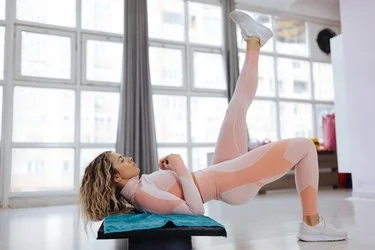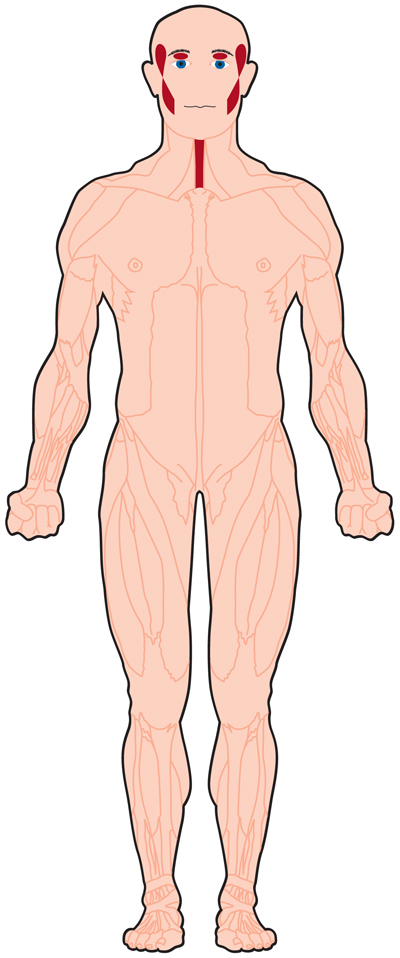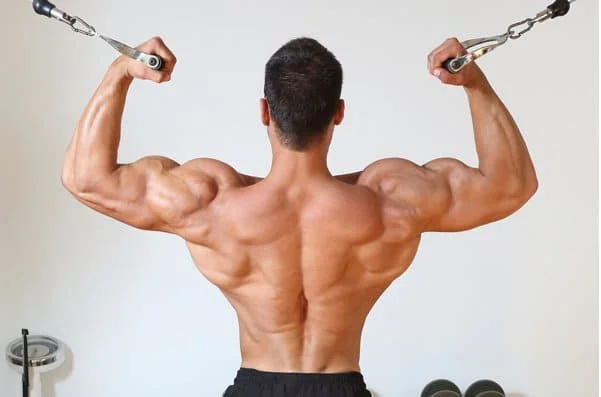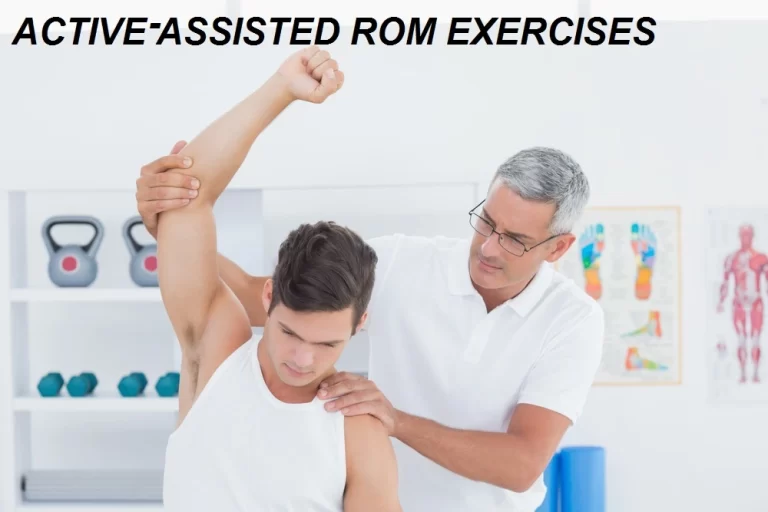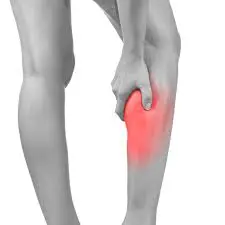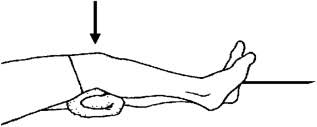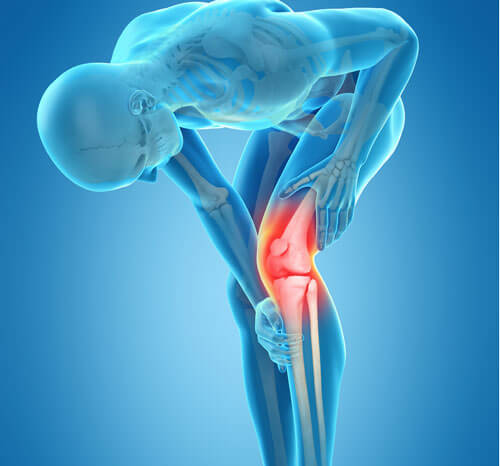54 The Most Effective Exercise for Upper Gluteal
Introduction
The upper gluteal muscles, also known as the gluteus medius and gluteus minimus, play a crucial role in hip stability and overall lower body function.
Targeting these muscles through specific exercises can help enhance their strength and development. Incorporating exercises that focus on the upper gluteal region can contribute to better hip function, improved posture, and overall lower body strength.
The glutes, also known as the gluteus maximus, medius, and minimus muscles, are a trio of large buttock muscles. They are essential for hip extension, abduction, and external rotation. The upper glute muscles, specifically the gluteus medius and minimus, are in charge of pelvic stability and upper body support.
Anatomy of the Upper Glute
The gluteus medius is the muscle that makes up the upper glute area. It is one of the three muscles that comprise the buttocks. The gluteus maximus and gluteus minimus are the other two muscles.
The glute medius is primarily in charge of keeping your pelvis stable during activities such as walking or running. The medius is the primary hip abductor. It generates the majority of the force required for activities such as lifting your leg to the side (laterally).
The glutes’ third function is medial hip rotation, or turning your thigh in.
What Is the Muscle on the Top of Your Buttocks Called?
The gluteus medius, also known as the upper glute or the glute shelf, is a muscle located at the top of your buttocks.
The gluteus medius is a stabilizer muscle, which means it helps to keep your pelvis level while walking.
It also aids in the rotation of your leg outward (external rotation).
The gluteus medius is one of the three major buttock muscles. The gluteus maximus and gluteus minimus are the other two.
How Can Your Upper Glutes Be Worked?
Since no muscle functions in isolation, we aim to activate both our upper glute max and glute med when working on our upper glutes. Your upper glutes are the focus of hip abduction and horizontally loaded hip extension movements.
Moving your legs away from your midline, or abduction at the hip joint, is mostly accomplished by the glute med and upper glute max. Therefore, we want to incorporate abduction movements, like a standing banded abduction, into our training programs to strengthen our upper glutes.
It’s simple to imagine this when you think about isolated exercises, but that won’t give you a booty shelf to talk about.
One of the most important things in developing the desired glute size and shape is to perform compound exercises that work the top and lower portions of our glutes. We need to know these muscles’ roles in order to know how to target them.
First, hip extension is attributed to the gluteus Maximus. Increasing the angle between the thigh and the pelvis, for example, can be achieved by standing up and shifting your leg rearward or out of a squat.
Certain exercises are designed to build the upper glutes more than the lower glutes, even though any exercise that requires hip extension will effectively target both the upper and lower sections of the gluteus Maximus.
These are hip extension exercises with a horizontal load. Squats are a type of exercise that is vertically loaded, whereas hip thrusts are a type of exercise that is horizontally loaded. Thus, when our goal is to grow the upper butt, these are the exercises we should include in our routines.
The gluteus medius is the second muscle group. The medius mostly facilitates abduction at the hip joint. This entails extending the leg out to the side and away from the body’s centre line.
It’s also important to remember that you may modify the exercise to better target your upper glutes when performing heavy lifts by just shifting your stance, placement, or adding a band. When we execute a hip thrust, for instance, and place a little band around our knees, we are highlighting the role that the upper glutes play in that movement.
Why Stay Focused on the Upper Glutes?
There are numerous reasons why working on your upper glutes is beneficial to both your physical health and your appearance. here is some reasons for focus on the upper glutes:
- Improved Posture and Body Alignment: Strong upper glutes help stabilize the pelvis and prevent excessive hip sway, resulting in poor posture and lower back and hip pain.
2. Reduced Pain and Injury Risk: Strong upper glutes support the lower back and hips, lowering the risk of pain and injury, particularly during activities involving hip flexion and extension, such as running, jumping, and climbing.
3. Improved Athletic Performance: Strong upper glutes are important for hip abduction, external rotation, and stabilization, all of which are necessary movements in many sports and athletic activities. Upper glutes that are well-developed can improve power, agility, and overall performance.
4. Aesthetics and a Rounder Butt: Strong upper glutes contribute to the appearance of more lifted, rounded, and defined buttocks. The upper gluteus medius and minimus muscles work together to form the “shelf” at the top of the buttocks, which is a desirable aesthetic feature.
5. Functional Upper Glute Strength for Everyday Activities: Strong upper glutes are necessary for everyday activities such as climbing stairs, getting out of a chair, and carrying heavy objects. They aid in the maintenance of balance, stability, and power during these movements.
In conclusion, targeting the upper glutes has some advantages in terms of both physical health and aesthetic appeal. Strengthening the upper glutes is a worthwhile endeavor whether you’re an athlete looking to improve performance, an individual looking to reduce pain and improve posture, or someone simply looking to improve your physique.
Upper Glute Training Tips
Here are some key upper glute training tips to help you maximize your results and reach your fitness goals:
Mind-Muscle Connection:
Make the mind-muscle connection a priority during each exercise. Throughout the movement, concentrate on feeling the contraction in your upper glutes. This will allow you to more successfully activate the target muscles and promote optimal muscle growth.
Proper Form:
To avoid injury and maximize muscle activation, maintain proper form throughout each exercise. Make certain that your core is engaged, your hips are aligned, and your movements are controlled. Improper form can cause compensation from other muscle groups, reducing the exercise’s effectiveness.
Progressive Overload:
As you get stronger, gradually increase the weight or resistance you’re lifting. This continuous challenge will stimulate muscle growth and keep your progress from decreasing. Begin with a weight that allows you to keep the proper form for 8-12 repetitions, then gradually increase the weight as you gain strength.
Incorporate Variety.
Include a variety of exercises that target the upper glutes from various angles and with different movements. This ensures you’re working all aspects of the upper glutes and promoting overall muscle development.
Variation in Set and Rep Ranges:
To target different muscle fibers and maximize your results, incorporate a variety of sets and rep ranges. Perform higher-rep sets (15-20 reps) for muscle endurance and lower-rep sets (6-8 reps) for strength and power, for example.
Rest and Recovery:
Take Regular Breaks between workouts for recovery. Muscle growth occurs during periods of rest, so it is important to allow your body time to repair and rebuild. Aim for 7-8 hours of sleep per night, and include rest days in your training schedule.
A well-balanced diet rich in protein, carbohydrates, and healthy fats will aid in muscle growth and recovery. Protein is required for muscle repair and growth, carbohydrates for energy, and healthy fats for hormone production and overall health.
Seek Advice:
If you’re new to exercise or have questions about proper form or technique, consult a certified personal trainer or fitness professional. They can offer personalized advice, ensure you’re using the proper form, and assist you in developing a training plan that aligns with your goals.
Remember that consistency and dedication are necessary for reaching your upper glute training objectives. Stick to your training plan and the tips listed above, and you’ll be well on your way to developing strong, shapely upper glutes and improving your overall fitness.
How to Increase the Size of Your Gluteus Medius
When trying to gain lean muscle mass, especially in your glutes, there are a few key things to keep in mind.
1. Make sure you’re getting enough calories.
The most important factor is probably calorie consumption. You will not have the energy to build new muscle tissue if you do not consume enough calories.
How many calories should you consume per day?
Simply multiply your body weight by pounds.
That is the absolute keep minimum!
By concentrating only on your fitness, you can strengthen your glutes and reap the associated benefits. People who want to develop their upper glutes and get a round shelf butt must eat enough calories to support healthy weight gain.
2. Increase your protein intake.
Protein is the most important macronutrient for developing and maintaining lean muscle tissue.
It is also the most thermogenic (fat-burning) nutrient, which means that your body will burn more calories digesting it than any other.
If you don’t consume enough protein, your body will struggle to build new muscle mass.
So, how much protein do you need to consume to bulk up your glutes?
A good rule of thumb is to consume at least half your body weight in protein per day.
If you weigh 150 pounds, you should consume at least 75g of protein per day.
Protein can be found in a variety of forms, but the best are:
- Chicken breast, lean
- Salmon caught in the wild
- Turkey
- Tofu
- Edamame and legumes
- Yogurt from Greece
Now let’s talk about my preferred method for expanding your upper shelf.
Aside from eating enough calories to promote weight gain, you must also be mindful of your food choices and consume adequate protein. The nutrient provides your body with the building blocks (amino acids) it requires to build muscle and repair damage caused by physical activity.
Most experts agree that we should aim for 0.7 to 1 gram of protein per pound of body weight. Poultry, fish, meat, eggs, cottage cheese, and protein powder supplements are examples of high-protein foods.
3. Perform glute-targeting resistance exercises.
The final piece of the puzzle for developing your upper glutes is resistance-based training.
You can strengthen your glutes by doing the following:
- Weights on the outside
- Bands of resistance
- As well as your body weight.
When performing each exercise, it is also important that you challenge yourself and feel your glute muscles working.
4. Including Upper Glute Exercises in Your Workout Routine
The glutes are almost always active due to their position and anatomy. However, proper exercise selection is a necessity for growing the upper glutes and strengthening the muscles.
The good news is that you can choose from a variety of upper buttock exercises, using resistance bands, machines, barbells, or your body weight as resistance.
Glute exercises are only effective if you concentrate on the right muscles. To ensure optimal development, choose weights that you can comfortably handle, perform each repetition smoothly, train with a full range of motion, and feel the upper butt area working.
5. Aim For Gradual Progression
The glutes, like any other muscle in the body, benefit from progressive overload, which involves gradually increasing the difficulty of your training.
Your upper glutes may initially respond to light tension, but you must push yourself to continue growing and strengthening the area.
Because the gluteus medius is small and difficult to isolate with weight, doing more repetitions is the simplest way to achieve this. You can concentrate on compound exercises like the hip thrust instead of lifting more weight.
The best exercise for upper gluteus
Gluteus Medius (upper glute)Stretching Techniques
Warming Up Your Glutes
A proper lower-body warmup should release and mobilize muscles while waking them up. If you sit most of the day, your glutes may become inactive. These are some of the best glute exercises to do before a butt workout to activate your glutes and increase your range of motion for heavier weighted lifts like sumo squats. Some exercises require the use of a mobility ball, a resistance band, and light dumbbells.
Before you begin, do 10 minutes of light to moderate cardio. This could be anything from power walking to jogging, biking, or even dancing around — whatever feels good and gets your blood pumping.
The gluteus medius is responsible for the upper and side parts of your buttocks. Stretching your upper glutes can help you avoid injury and alleviate pain in your lower back, knees, and hips.
The gluteus medius is a muscle that is frequently overlooked. It is, however, the muscle responsible for abducting (moving the leg away) from your body.
Taking the time to stretch this muscle has many advantages, including loosening up tight hips.
Tight hips can reduce the range of motion and even cause chronic back pain.
You’ll be showing your glutes (and hips!) some love by using these gluteus medius stretches that also serve as hip openers.
Warming up your muscles is important before stretching them, especially if they are tight. Stretching, like any dynamic exercise, can strain your muscles.
Some of the stretches may also be easier to go deeper into.
- Warm-up suggestions
- Light aerobics with repeated motions is an option
- jogging
- walking
- jacks of all trades
Another suggestion is to stretch immediately after taking a hot shower or bath.
It’s never a good idea to stretch your muscles when they’re “cold.” Warming up first helps to prevent injury or strain
1. Cross-legged glute stretch
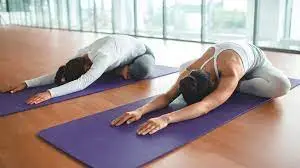
Begin with this simple stretch to get things started.
Here’s how to go about it:
- Sit cross-legged on the ground, with your left foot tucked into your right thigh. Your left shin would be in front of your right shin.
- Gently lean your torso forward over your crossed legs, arms outstretched.
- Maintain the stretch for 30 seconds.
- Repeat the stretch by tucking your right foot into your left thigh.
Tips
Lower your body toward your legs even more if you want to deepen the stretch. You can also extend your arms further.
Reduce the depth of the stretch to make it easier. Alternatively, use a block to rest your hands on.
2. Z-sit

Similar to Pigeon Pose, which is frequently recommended to stretch the gluteus medius, a Z-sit reduces some of the discomfort associated with Pigeon Pose while remaining a great hip opener.
Here’s how to go about it:
- Begin by sitting down on the ground.
- Bring your left knee up to a 90-degree angle in front of your body (as far as your body will allow).
- Repeat with your right leg toward the back of your body.
- In this pose, you can sit upright or lean forward toward your front leg.
- Hold the position for 30 seconds before alternating sides.
Tip
Use your breath to move deeper into the stretch in this pose.
3. Standing figure four
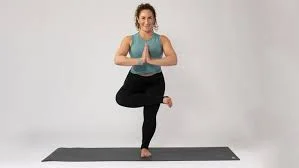
This stretch has numerous variations, making it an excellent choice for this muscle. Here’s how to go about it:
- Begin by sitting upright with your spine neutral.
- Cross your left foot over your right foot. Place one hand on your knee and one on your ankle.
- Lean your torso forward to a comfortable position.
- Maintain this position for 5 breaths.
- Return your leg to the starting position and do the same on the other side.
Tip
When stretching, remember to relax your muscles. You may be tensing them without realizing it.
Variations
This exercise can be done while lying down in a supine position. That is an excellent time to wrap a strap around your bent or raised leg to assist with stretching.
You can also make the pose more relaxed by placing your foot against a wall. Shimmy forward as far as you can to the wall, until your hips are directly over your knees.
Standing is a good way to put your balance to the test. Form a figure four with your legs, then lower your knees as if sitting in an invisible chair.
4. Standing side stretch

This stretch will also stretch your upper body. Here’s how to go about it:
- Stand with one side of your body against a wall for balance.
- Place the leg furthest away from the wall in front of the other.
- Put one hand on the wall and one on your hip. Then, lean your upper body away from the wall while pushing your hip toward it.
- Hold for 20 to 30 seconds before repeating the process on the opposite side.
5. Massage your glutes / Tennis Ball Massage
How to do it:
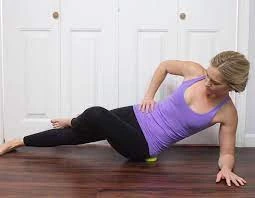
- Take care of your glutes by getting a massage or using a foam roller/ball to massage the muscles in this area.
- Rotate your lower body to the side and upper part of your gluteus medius while sitting on the foam roller to target your gluteus medius.
- If you don’t have a foam roller, use a tennis or lacrosse ball.
Upper Gluteal Exercise without Equipment / At Home
1. Clamshell on its side /Clamshell exercise
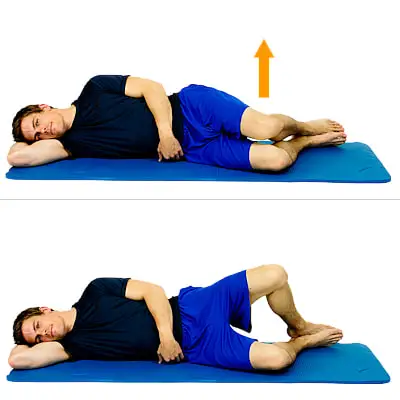
How to Go About It:
- Lie on your side on the floor with your knees bent 90 degrees.
- You should stack your knees and feet.
- Place one hand on your glutes and push through your heel while rotating your hip open and raising your knee to the ceiling. The motion should be similar to that of a clamshell opening.
- To return to the beginning, reverse the motion. That is one repetition.
Expert advice:
Hold for 1-2 seconds at the top of the raise while squeezing your glutes.
Variation:
To make the exercise more difficult, wrap a resistance band around your knees.
2. Single-leg Gluteal Bridge
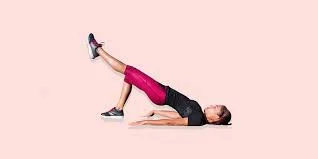
How to Go About It:
- Place your right heel on the floor and extend your left leg while lying face up on the floor.
- Brace your abs and contract your glutes to lift your hips off the floor while raising your left leg into the air until it is parallel to your right thigh.
- Lower yourself.
- That is one repetition.
Expert advice:
To avoid strain, end your hinge at your shoulders as opposed to your neck.
Variation:
This is a modified version of the suspended single-leg glue bridge move, in which your bent leg is suspended by a harness.
3. Romanian Deadlift on One Leg
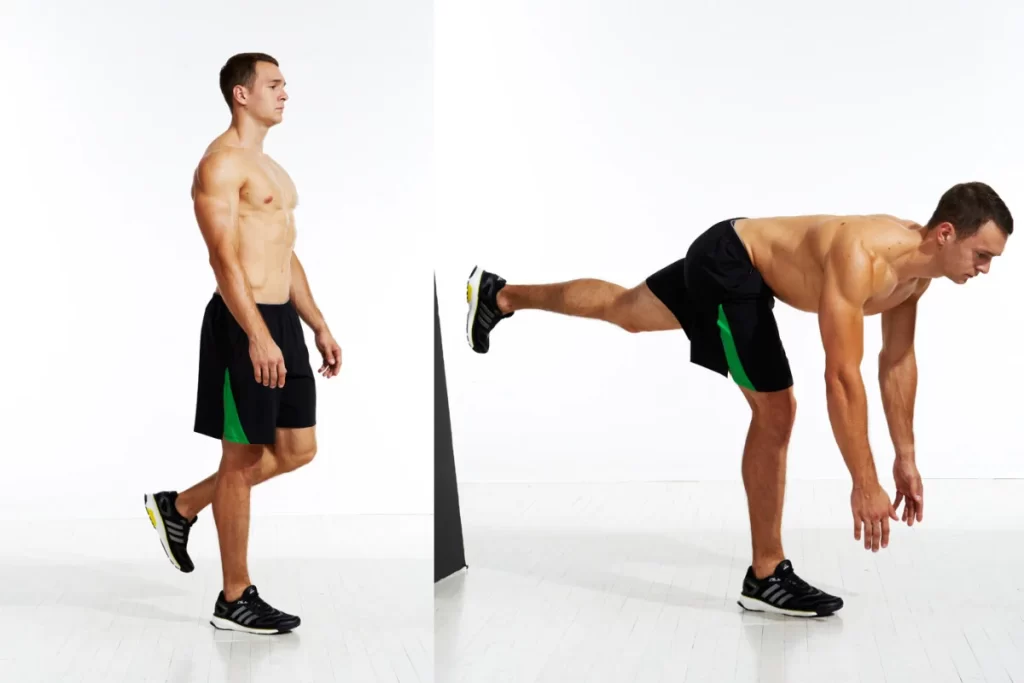
How to Go About It:
- Stand on your right leg and push your hips back as far as you can while reaching with both hands in front of you.
- Allow your knees to bend as needed while your torso moves toward the floor, keeping your lower back arched.
- Go as low as you possibly can and hold it for one second.
- To get back up, squeeze your glutes. That is one repetition.
Expert advice:
As you lower your torso, keep your head in line with your shoulders. This will help you keep your back in shape.
Variation:
This move can be performed with or without weights (dumbbells or a kettlebell).
4. Table-Up in Reverse
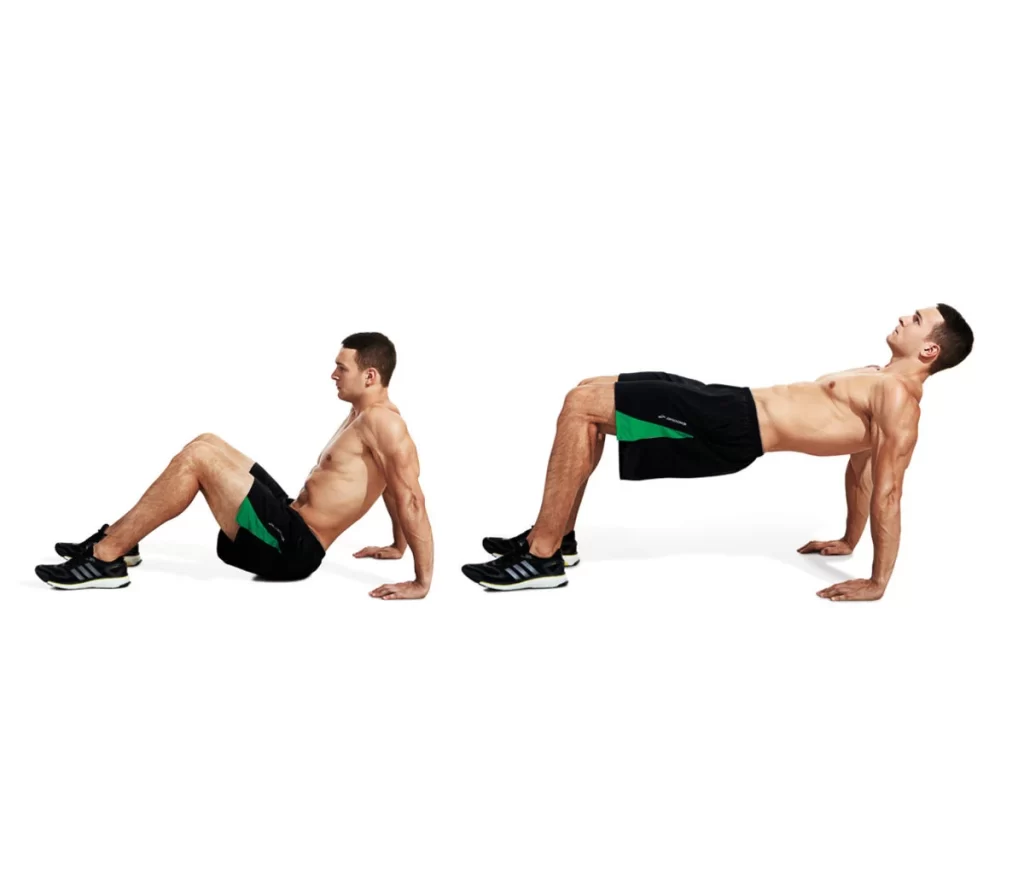
How to Go About It:
- Sit on the floor and place your hands under your shoulders, fingers pointing forward.
- Squeeze your glutes and place
your feet shoulder-width apart. - As you bridge your hips up, push through your heels.
- Your body should be arranged in the shape of a table, with your torso and hips parallel to the floor.
- Hold for two seconds before lowering back down. That is one repetition.
Expert advice:
Turn your fingers outward for better support if you’re experiencing pain in your wrists or shoulders.
Variation:
Instead of maintaining a neutral neck, another variation of this move involves allowing your head to fall back behind your shoulders at the top of the move.
5. Squat Jump
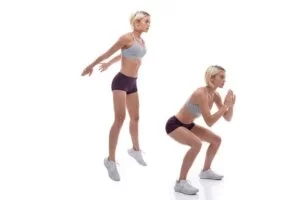
How to Go About It:
- Place your feet shoulder-width apart. To descend into a squat, bend your knees and hinge at the hips, bringing your hands in front of you.
- Pause once the thighs are parallel to the floor, then engage the quads, glutes, and hamstrings to explode upward.
- Land with your knees soft. That is one repetition.
Expert advice:
Engage your arms for maximum explosion and landing balance.
Variation:
This move has a 180-degree variation in which you add a turn to the jump and land facing the opposite direction.
6. Single-leg squats

Single-Legged Squat
Butt and Legs Body part
Goal: Muscle Growth
- Stand tall with your shoulders back and your feet hip-width apart.
- Lift your right foot off the floor in front of you, keeping your leg straight.
- Straighten your arms in front of you.
- Maintaining a neutral spine, bend your left knee and lower toward the ground, pushing your hips back.
- When your lifted leg is the same height as your bent leg, come to a halt.
- Begin with shallow squats and progress to deeper squats as you are able.
- Repeat on the other side.
Tip
Begin with no weight and gradually progress to dumbbells as your balance and strength improve. If you’re having trouble performing the single-leg squat, try leaning against a wall or holding onto a chair for support. Make certain that your knee does not extend past your toes.
7. Hip Side-lying Raise
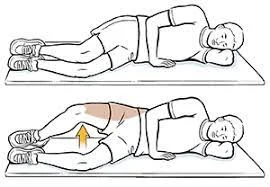
Here’s how to go about it:
- Lie on your side and rest one elbow/forearm on the ground.
- Kneel on both sides.
- Raise your hips off the floor while abducting your top leg.
- Maintain bottom knee contact with the floor and both knees bent.
- Slowly lower your hips to the floor.
- Repeat the movement, making certain to train both sides equally.
8. Bulgarian Split Squats (Rear Foot Elevated Split Squats)
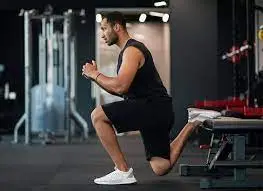
Here’s how to go about it:
- Face away from a platform or a short chair in front of you.
- Put your back foot on the platform and balance on your front foot.
- Squat as low as you comfortably can by bending the front knee.
- Repeat standing up slowly.
- Make certain that both sides are trained equally.
*Note: If the Bulgarian split squat is too difficult, you can substitute reverse lunges or walking lunges.
9. Pulse Ups on the Prone
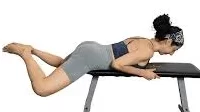
Here’s how to go about it:
- Place your hips on the edge of a bench, face down.
- Make a diamond shape with your legs, so that the soles of your feet are touching.
- Pulse your feet up while keeping them in contact with your core and glutes engaged.
- Return to your starting point and repeat.
10. Fire Hydrant Kicking
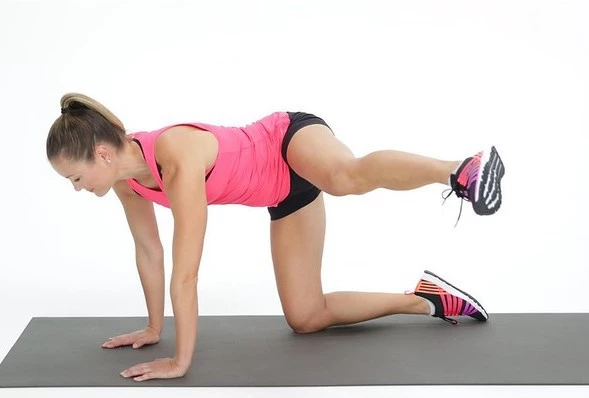
Here’s how to go about it:
- Place your hands and knees in a quadruped position.
- Keep your back flat and externally rotate and abduct one of your hips. Kick your leg out to the side, pointing your toes forward.
- Return to the starting position by bending your knee.
- Repeat, making sure to train the opposite side.
- After the fire hydrant kick, you can do donkey kicks by driving your heel up toward the ceiling.
11. Box Squat with One Leg
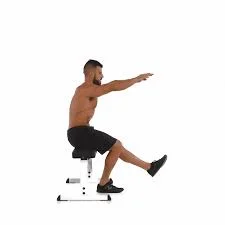
Here’s how to go about it:
- Take a chair or box and stand about 12 inches in front of it, feet shoulder-width apart, toes pointing out.
- Lift one leg in front of you and balance on that leg.
- Squat down until your buttocks make contact with the box or chair, bending at the hips and knees with your working leg.
- Return to the beginning position and repeat.
- Make sure to train the opposite leg as well.
Exercises for Upper Glutes with Equipment
1. Glute Bridge Suspension Trainer for One Leg
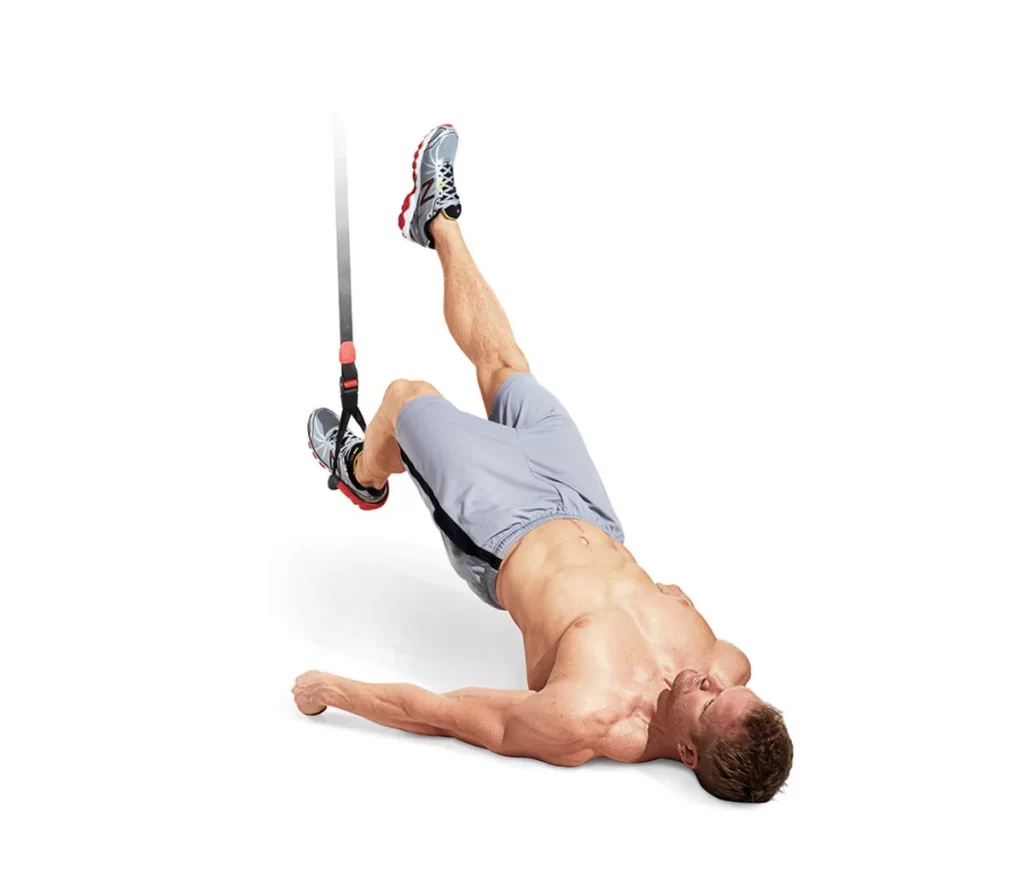
How to Go About It:
- Attach the suspension trainer to a strong overhead object and extend one handle to about knee height.
- Place the heel of your left foot in the foot cradle while lying on your back on the floor.
- Extend your right leg and bend your left knee 90 degrees.
- Brace your abs and contract your glutes to lift your hips off the floor while lifting your right leg into the air until it is parallel to your left thigh. That is one repetition.
Expert advice:
With each bridge, let your hinge stop at your upper back as opposed to your neck.
Variation:
There is a floor version of this move in which the foot of your bent leg remains on the floor instead of becoming suspended.
2. Wall Squat with Swiss Balls
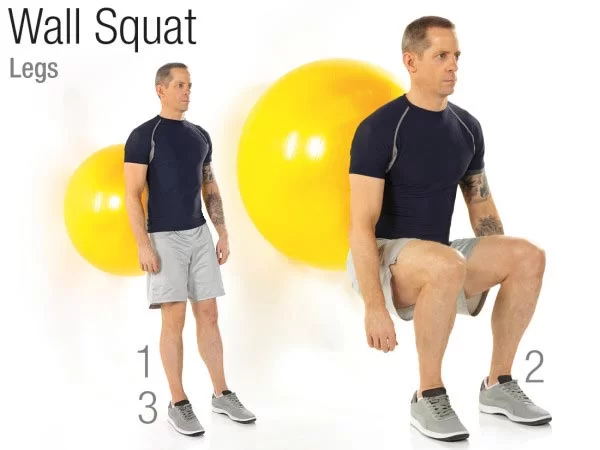
How to Go About It:
- Place the ball against a wall and hold it in place with your back to it.
- Put your feet shoulder-width separate and turn your toes out 15 degrees.
- Squat as low as you can and roll the ball down the wall.
- To stand, push through your heels. That is one repetition.
Expert advice:
Firmly press your back against the ball, but not so hard that you feel excessive strain on your back.
Variation:
For an added challenge, perform this move while holding dumbbells.
3. Leg Curl with a Swiss Ball
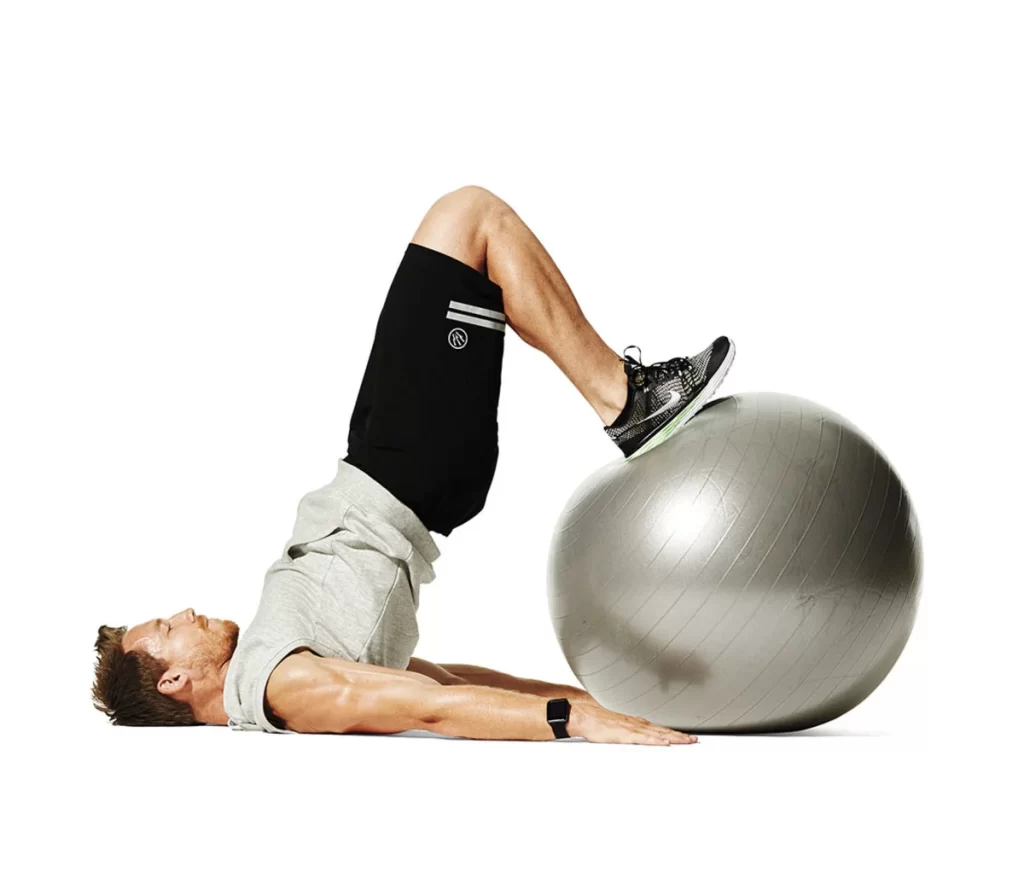
How to Go About It:
- Lie on the floor with your legs straight and your heels on a Swiss ball.
- Raise your hips to the point where your body is straight.
- Pull the ball toward your buttocks with your heels while keeping your toes pulled toward your shins.
- Then, with your legs extended, push the ball away from you. That is one repetition.
Expert advice:
Keep your core engaged throughout this movement to prevent your hips from dipping. Also, make sure to do this move on a surface that allows the stability ball to move freely without slipping.
Variation:
This exercise targets the same muscles as the standard glute bridge and banded glute bridge.
Exercises for Target of Upper Glutes with Weight
The gluteus medius helps with hip abduction, or moving your leg away from your midline.
You’ll need dumbbells, a barbell, or a weighted plate for these glute exercises. To find your ideal dumbbell, pick a weight you can lift 10 times with good form, but the last two reps should be challenging.
Any exercise that involves abducting your hip will work the top part of your glute.
The best part is that you can perform these exercises from a:
- Position of standing,
- Lying on one’s side,
- Quadruped posture,
- Supine (on your back) position, or
- Prone position (on your stomach).
Upper Glute Exercises That Work
Now, let’s go over some of my favorite upper glute exercises.
They are classified as:
- Weighted,
- Body weight,
- Banded.
The weighted exercises come first.
1. Single-Legged Deadlift
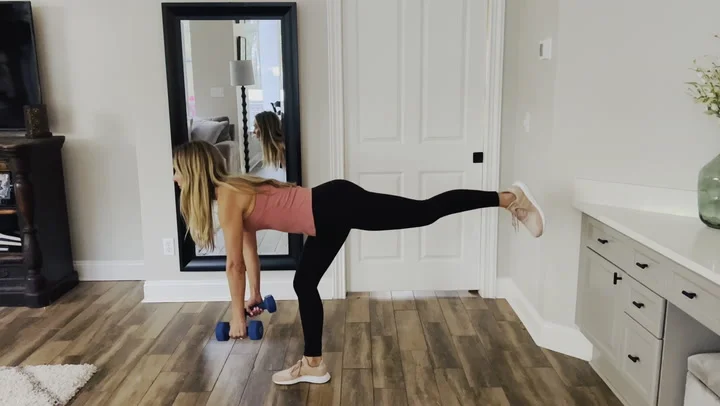
Single-Legged Deadlift
The parts of the body Buttocks, Legs, and Back
GOAL: Muscle Growth
- Keeping a dumbbell in per hand, stand with your feet hip-width separated.
- Push your hips back and forward at the waist, allowing the dumbbells to fall to the ground with straight arms.
- Allow your left leg to extend straight behind you while your arms, back flat, move toward the ground.
- Continue forward until your body forms a straight line parallel to the floor, with your left leg straight behind you.
- Reverse the motion and return your left leg to the starting position.
- Rep on the other side.
2. Dumbbell Squat Sumo
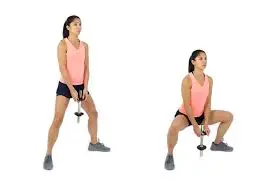
Squat Sumo with Dumbbell
Butt and Legs body part
GOAL: Muscle Growth
- Stand with your feet slightly wider than hip-width apart, toes at a 45-degree angle pointed out. (Move your feet in closer if the position is uncomfortable).
- Straighten your arms and hold a dumbbell in each hand in front of you.
- To squat, keep your back straight and push your hips back, then bend your knees out over your toes. Consider sliding down a wall while keeping your back straight and avoiding leaning forward or sticking your butt out.
- Lower your thighs until they are parallel to the floor (or as low as you can go).
- To return to a standing position, activate your core, glutes, and quads to propel your body back upright, driving your weight through your feet.
- Repeat by squeezing your glutes at the top of the movement.
3. Donkey Kick with a Weight
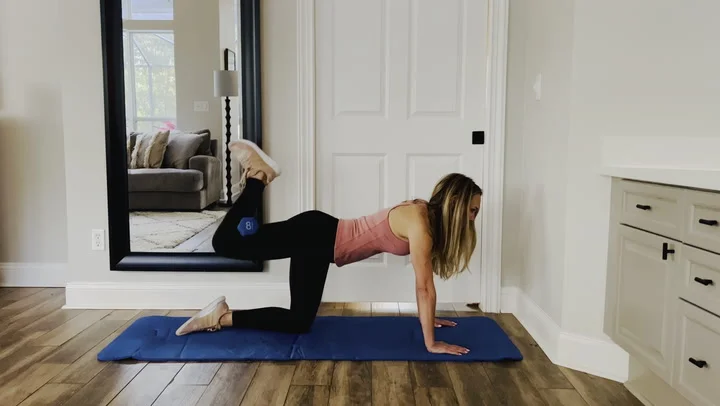
The parts of the body Buttocks, Abs, and Legs
GOAL: Muscle Growth
- Begin on all fours, hands under each shoulder, knees in line with hips.
- Put a dumbbell behind your right knee or ankle weights on.
- Reach your right foot toward the ceiling while keeping your right knee bent to keep the dumbbell in place.
- Raise your right leg as far as possible while keeping your knee bent and your back neutral.
- Return to the starting position by squeezing your glutes at the top.
- Repeat on the other side.
4. Weighted Hip Abductions While Standing
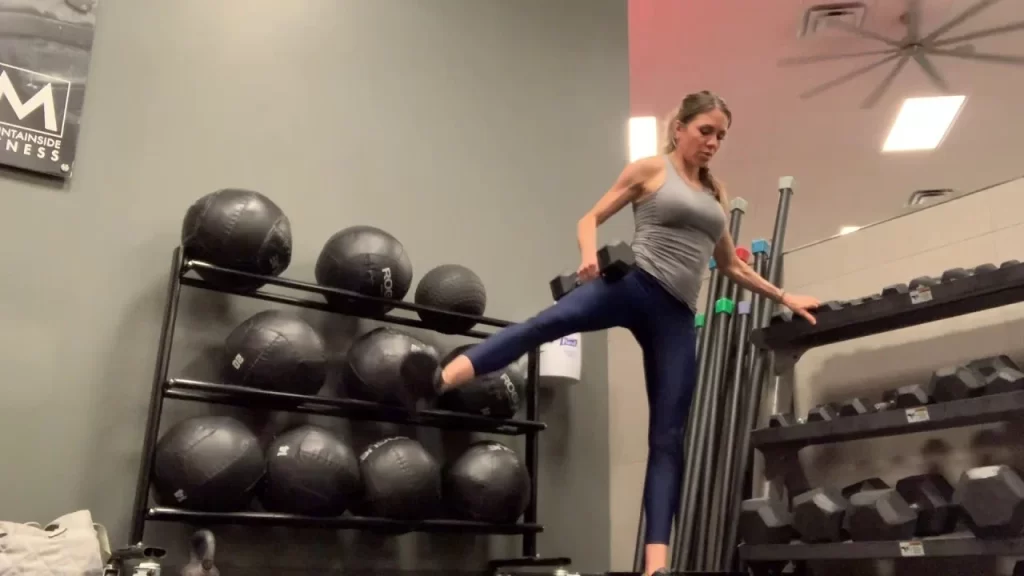
Here’s how to go about it:
- Place your feet together on an elevated platform and your hand against your hip or a wall. (When lowering your working leg, the platform allows it to move in a wider range of motion).
- Hold a dumbbell, kettlebell, or weighted plate against your leg with the other hand.
- Abduct the leg with the dumbbell against it while keeping the other leg straight and your foot on the ground.
- For 1 second, hold the top position.
- Return your leg to the center and repeat.
- Make certain that both sides are trained equally.
5. Lateral Dumbbell Lunge
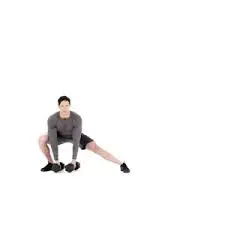
Here’s how to go about it:
- Stand up straight with your feet together and two dumbbells or free weights at your sides.
- Step out one floor laterally, with your toes pointing forward.
- Squat down to the side from which you stepped out.
- Maintain a straight other leg with your foot planted on the ground. (This exercise works the inner thighs as well.)
- Repeat standing up with your feet together.
- If balance is an issue, use a chair instead of dumbbells, or try a weighted vest.
6. Romanian Deadlifts with Elevated Dumbbells
Romanian deadlifts are an excellent compound exercise that targets a variety of lower-body muscle groups.
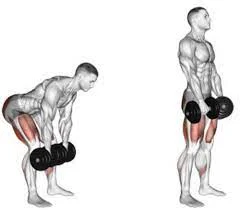
Here’s how to go about it:
- Take two dumbbells and place them at your sides.
- Place your feet hip-width apart on a platform. (The platform is useful if you are ready to step outside your comfort zone.)
- Begin by bending at the hips while maintaining a neutral spine and pushing your buttocks back as if to touch an imaginary wall behind you.
- You can bend your knees slightly, but your arms should be straight down at your sides.
- Return to your starting point and repeat.
Best Gym Glute Exercises
1. Hip Thrust with Weight
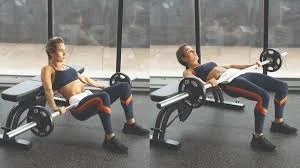
Here’s how to go about it:
- Sit, and Maintain a straight back and both knees bent.
- Cross your hips with a dumbbell, barbell, or weighted plate.
- Now, press your heels down and squeeze your glutes to lift your hips.
- At the top, your upper back will naturally lie flat on the bench.
- Maintain this position for one second.
- Return to your starting point and repeat.
2. Glute Bridge with a Barbell

How to Go About It:
- Lie down, legs extended, Roll the bar up your thighs until it sits on your lap (for added comfort, place a towel on your hips or attach a pad to the bar).
- Brace your abs and push your heels into the floor to bring your hips in alignment with your body.
- After you’ve rested, simply slide your body under the bar and begin the glute bridges.
Helpful hints
As you raise your hips, resist your impulse to rise onto the balls of your feet.
Variation:
A one-leg variation is also possible. If using a barbell is difficult for you, use your bodyweight or free weights (weight plate or dumbbells).
To make a one-leg variation more difficult, inch yourself up against a wall or bench until your trunk is about a foot away. Place your planted leg flat on the ground. Raise your “non-working leg” into the air while keeping your knee bent. As you raise your hips into the glute bridge, drive your heel against the surface.
3. Reverse Lunge with Dumbbells

How to Go About It:
- Grasp a dumbbell in your right hand and stand a few inches above the floor on a step or block.
- Step back with your right foot and lower your body until your left thigh is parallel to the floor and your back knee is almost touching it.
- Maintain a straight posture with your torso.
Expert advice:
Your step back should be wide enough to stretch your calf and hamstring, but not so wide that it pulls your hips backward.
Variation:
This move can be performed without the use of a step or block as a starting point.
4. Romanian Single-Leg Deadlift
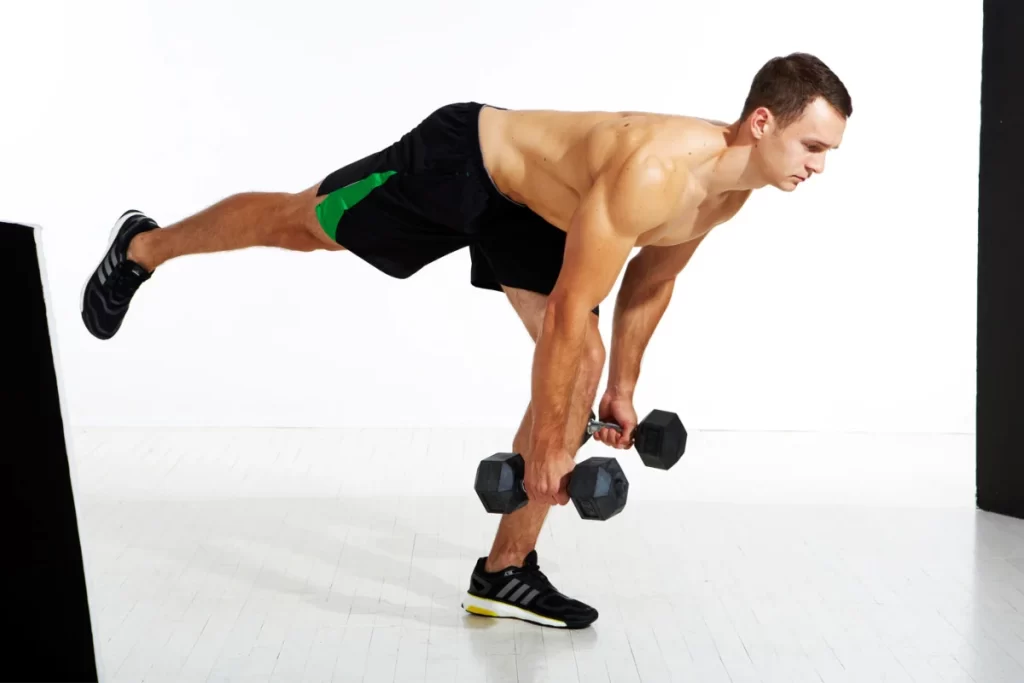
How to Go About It:
- Stand tall with your arms at your sides and a dumbbell in each hand. Allow your knees to sag into a neutral, slightly bent position.
- Step back with one leg; this non-weight-bearing leg should extend straight back until it’s parallel to the floor, while your planted leg remains engaged and firmly planted to the floor.
- Bend at the hips as far as you can without losing the arch in your lower back as you draw your elevated leg back. To avoid hyperextension, keep your weight-bearing knee neutral or slightly bent.
- Sink your arms to the ground. Pull yourself back to an upright position by using your glutes. That is one repetition.
Expert advice:
As you return to the starting position, contract your glutes. This could reduce the strain on your lower back.
Variation:
There’s the traditional Romanian deadlift, which uses a barbell. You stand with your feet hip-width apart, holding a barbell with a shoulder-width grip. Then, as you lower the bar along your shins, slightly bend your knees until you feel a stretch in your hamstrings.
5. Squat Bulgarian Split
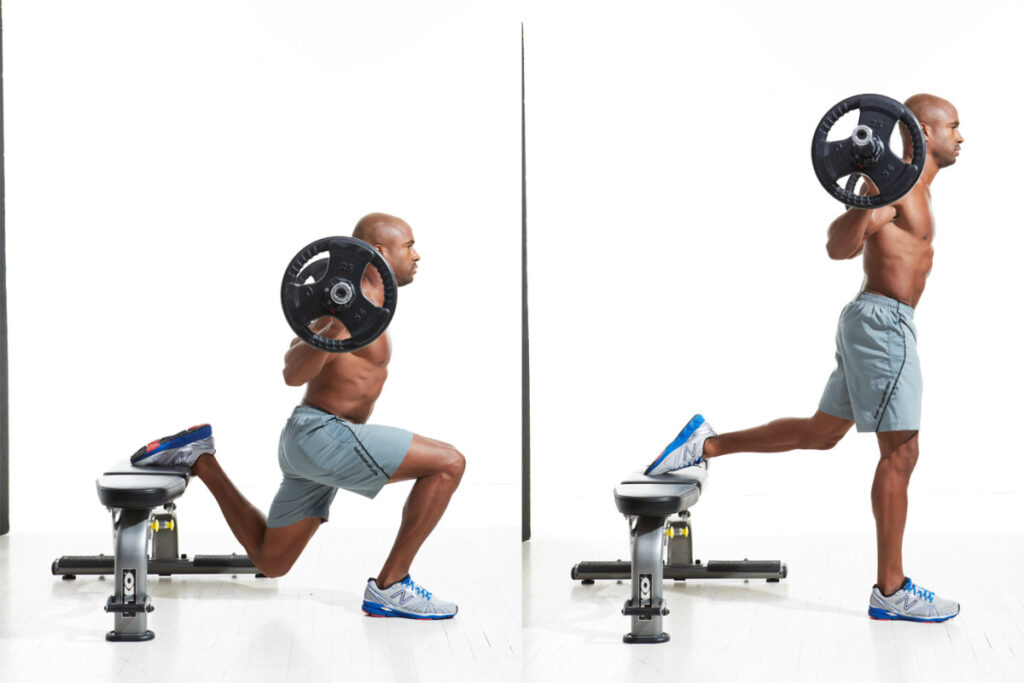
How to Go About It:
- Squat with a bar on the backs of your shoulders.
- Place the top of one foot on a bench or box behind you, bending your back knee 90 degrees.
- Lower your body by bending your hips and right knee until your back knee nearly touches the floor. To rise, drive through your planted leg. That is one repetition.
- Maintain a straight posture with your torso. If you don’t want to use a barbell, hold dumbbells at your sides instead.
Helpful Hint
Maintain a strong and aligned upper body posture throughout the movement. Maintain a shallow dip for more emphasis on the quads, and a deeper dip for more emphasis on the glutes.
Variation:
Begin by interlocking your fingers behind your head for beginners. Then switch to a medicine ball before moving on to dumbbells or kettlebells.
6. Sumo Deadl Romanian

How to Go About It:
- Stand with your feet wider than shoulder-width apart and your toes turned out about 15 degrees.
- Bend your hips and knees as needed until you can grasp the bar at shoulder width.
- Push your hips forward to raise the bar to lockout while keeping your lower back in its natural arch. That is one repetition.
- Push your hips back and lower the bar to mid-shin level to begin each subsequent rep.
Expert advice:
Make it a deadlift by bending your knees even more—the movement must come almost entirely from your hips.
Variation:
There’s also a dumbbell single-leg variation of this move, in which you lean forward while lifting one leg straight behind you, with a dumbbell in each hand at your sides. The dumbbells should move from your sides to directly over your planted foot as your chest moves forward.
Return to the starting position by lowering your back leg and bringing the dumbbells back to your sides.
7. Squat with a Barbell
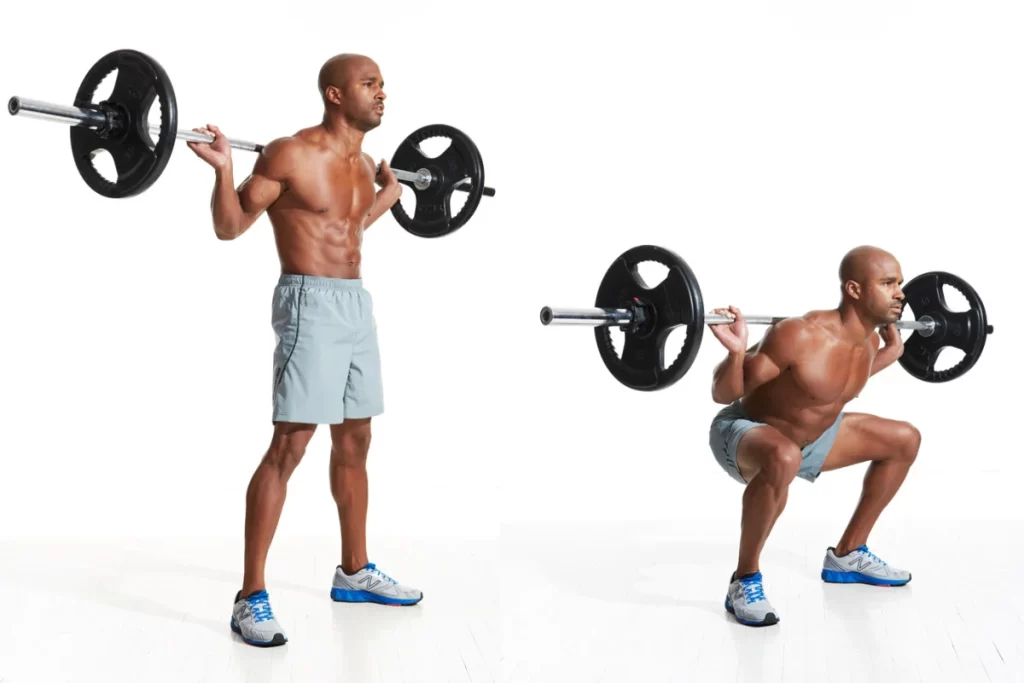
How to Go About It:
- Set up in a squat rack or cage and step under the bar with your hands as wide apart as possible.
- Step back and stand with your feet shoulder-width apart and your toes turned outward slightly.
- Take a deep breath and bend your hips and knees as far as you can without losing the arch in your lower back.
- As you descend, push your knees outward.
- Come back up by extending your hips and pushing your knees outward. That is one repetition.
Variation:
This move can be performed in a variety of ways. The overhead squat, in which you perform the move while holding the bar above your head, and the goblet squat, in which you hold the weight in front of you, are two of them.
8. Deadlift with a Trap Bar
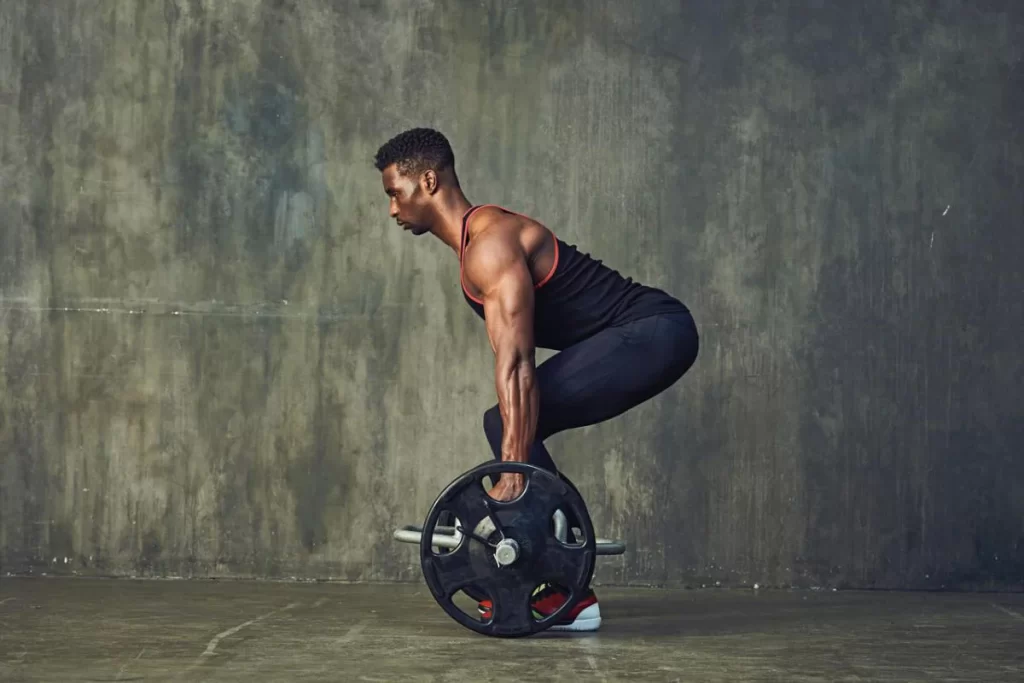
How to Go About It:
- Place your feet hip-width apart.
- Hinge at the hips, bend your knees, and lower your hands to grip the handles in the middle of the bar.
- Inhale and brace your abs as you retract your neck and look at the floor several feet ahead of you, making a double chin.
- Maintain a flat back as you drive your heels into the floor and raise the bar, pushing your knees out to prevent them from collapsing in.
- Stand tall, squeezing your glutes and locking your hips out (without leaning back).
Expert advice:
Your middle finger’s big knuckle should be in line with the center of the bar.
Variation:
The deadlift can be done in a variety of weight variations. This move can also be performed with resistance bands.
9. Step up with Dumbbells
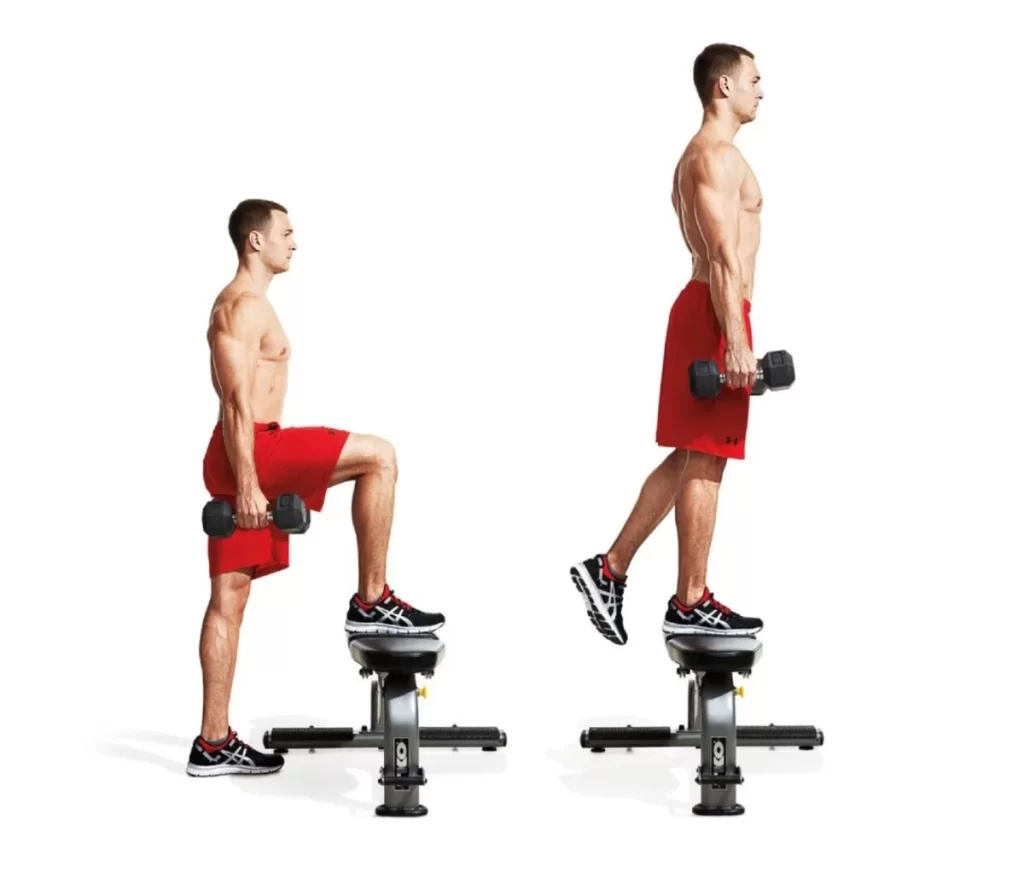
How to Go About It:
- Stand perpendicular to a bench or other elevated surface so that when you step on it, your thigh is parallel to the floor.
- Step up onto the bench with a dumbbell in each hand, leaving your trailing leg hanging off.
- To stand, drive through your front heel.
- After a little delay, return to the beginning position slowly. That represents a single recurrence.
- You can also perform lateral dumbbell step-ups while standing parallel to the bench, and you can add a jump to either variation by driving through your planted foot and landing softly on the trail leg.
Helpful Hint
You can work on one side at a time, switching up the legs. Maintain a forward-leaning posture with your upper body to incorporate as much as possible.
Variation:
A reverse lunge, in which you drive your trailing knee up toward your chest as you step up, and then step back into a reverse lunge once you’re back on the floor, could be included in this move.
10. Machine for hip abduction
If you want to isolate and bulk up a muscle, using a machine is always a smart alternative. The hip abductor machine checks off several of the ‘How to Select the Best Hypertrophy Exercises?’ boxes, including having an ideal strength curve, a high degree of stability, and the capacity to readily apply progressive stress – all of which are important criteria when it comes to muscle growth.

Example of Hip Abduction Exercise
How to:
Set the knee pads on the abductor machine so that your legs begin close together yet in a comfortable posture. Choose a weight that corresponds to your target rep range.
Push your knees outwards while keeping your back on the pad. You’ve achieved the apex of the exercise when you feel a stretch in your upper glutes. Slowly return to the beginning position.
You’ll note that several of the workouts need the use of a resistance band as you go through the post. There are several advantages to using a resistance band, but we recommend them while exercising the glutes because of their particular resistance curve. The workout becomes increasingly challenging as you progress through the routine because the band stretches. This means that the highest resistance will be at the highest point of the action, causing us to push hard and recruit a large number of muscle fibers.
11. Glute Bridge KAS
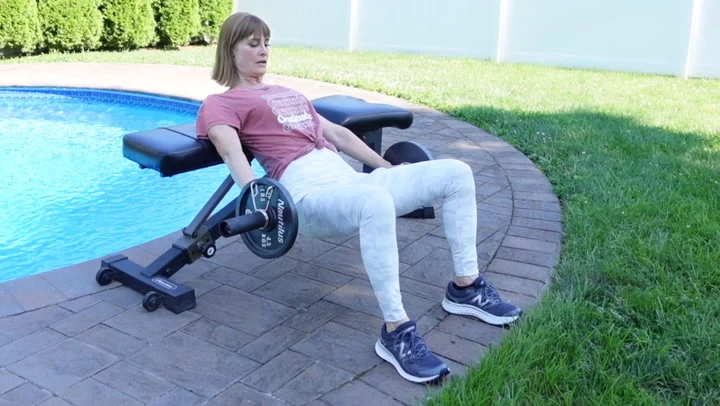
The KAS glute bridge is a fantastic exercise to engage the upper glutes, much like the barbell hip thrust. Similar in setup to the Barbell hip thrust, the KAS glute bridge tries to keep the shins perpendicular to the floor and prevents the knees from going all the way toward the torso instead of sinking the hips to the floor. As a result, there will be much less range of motion, but we can maintain continuous strain on the glutes, which helps to create a rounded, sculpted appearance.
How to apply
As with the barbell hip thrust, prepare a flat bench and position a barbell parallel to it that is loaded with the desired amount of weight.
Place your shoulder blades against the bench’s side while you sit on the ground in front of it.
Roll the barbell over your thighs and onto your pelvis while keeping your legs flat on the floor.
Using both hands, grasp the barbell and maintain it above the pelvis.
To flex your knees, bring your feet up to your buttocks.
We must drive through our heels and raise our hips towards the ceiling to get to the starting posture.
The starting position is when your thighs are in line with your back.
Decelerate the weight till it touches the ground. You’ll notice that your knees begin to move closer to your body as you pass a certain point. It will now be necessary to raise the weight to the ceiling once more. The goal of this exercise is to maintain the knees parallel to the floor. That’s the idea—the range of motion will be far less than the barbell hip thrust.
After completing the required number of repetitions, reduce the weight until it reaches the floor.
12. Squat with a Goblet
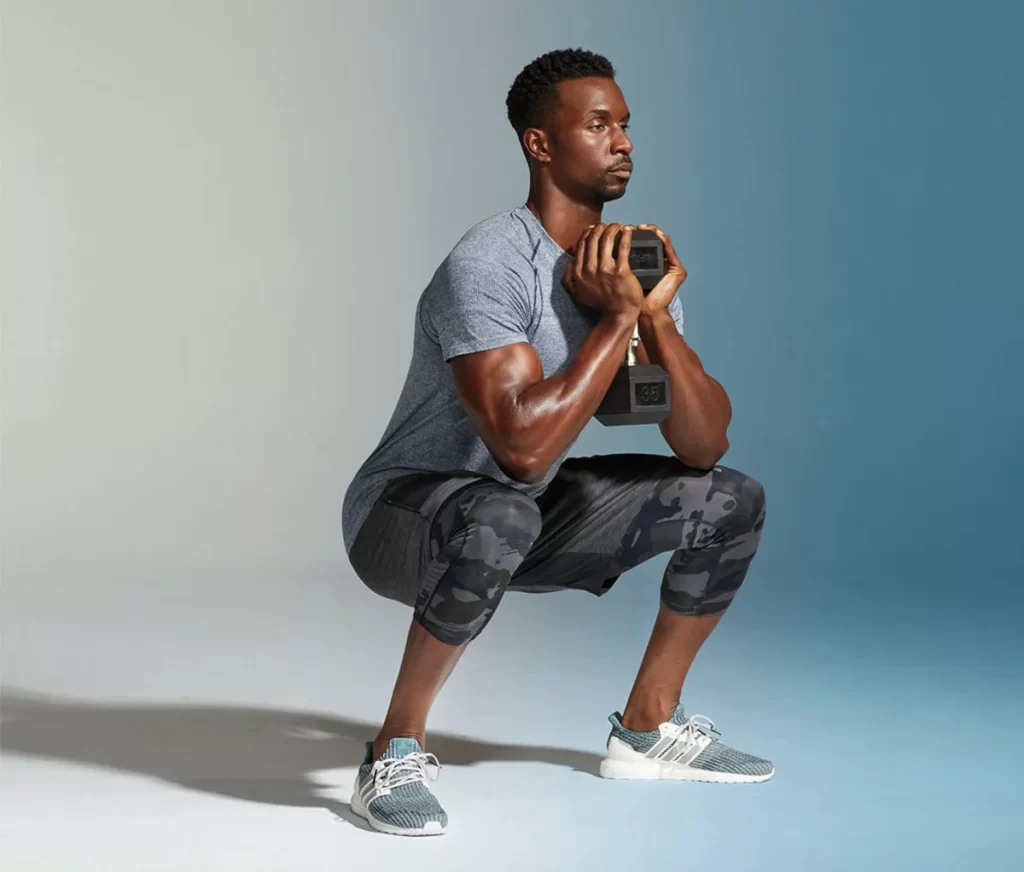
How to Go About It:
- Use two hands to hold a dumbbell or kettlebell.
- Squat by sitting your hips back and down, keeping your weight in your heels, and not lifting your toes.
- At the bottom of the squat, your elbows should be touching your knees. To rise, extend powerfully through the hips. That is one repetition.
Expert advice:
Hold for a beat at the bottom of the move to avoid bouncing or rocking your hips.
Variation:
Allow your elbows to drop slightly below your knees, but not so far that the weight falls below your chest.
13. Landmine Squat
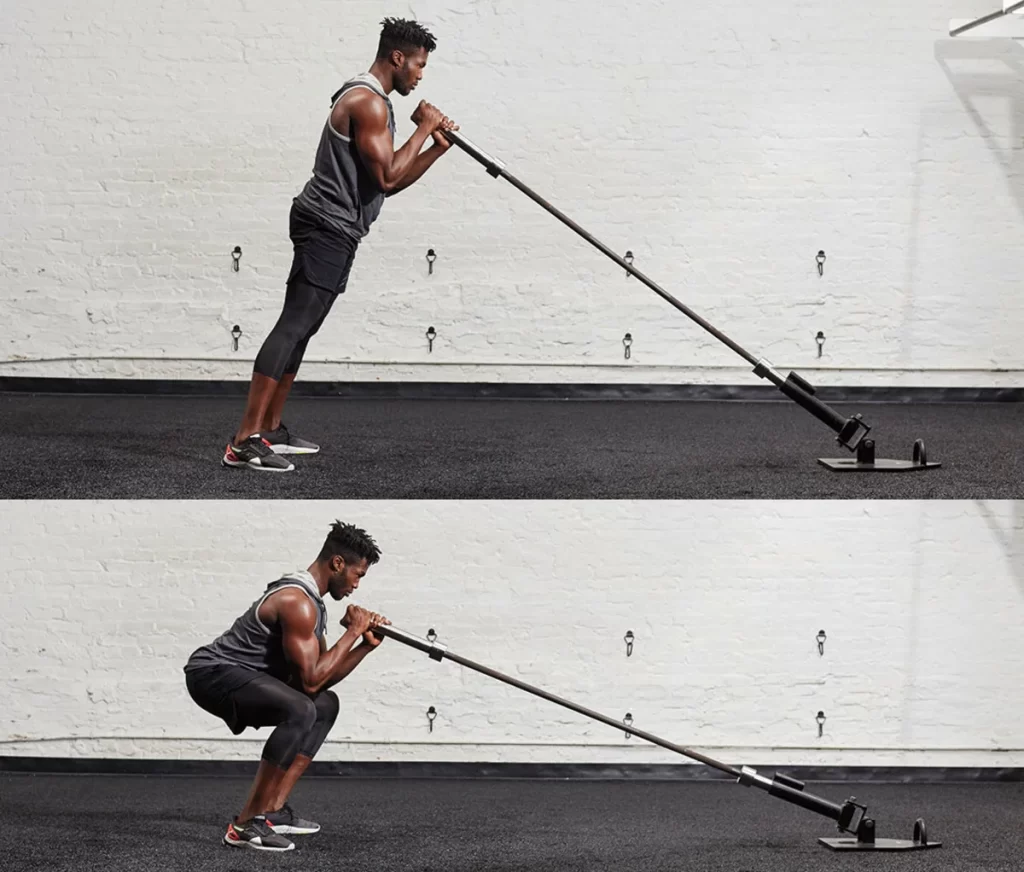
How to Go About It:
- Face the landmine while holding a barbell fist-over-fist with the thumbs on top. To begin, take a step back and lean forward, putting some of your body weight into the barbell.
- Drop into a squat until the barbell is just under your chin, then reverse. That is one repetition.
Expert advice:
Increase the width of your stance to deepen your squat and engage more muscle groups.
Variation:
This move has many variations, including the sidekick squat, pistol squat, and prisoner squat.
14. Pull through cable
When you think about it, this exercise is essentially simply a standing version of a hip thrust. Your glutes must contract strongly to move the weight forward because the load is behind you, just like in a hip thrust or glute bridge substitute. Once more, the exercise’s cable structure keeps the joints from being overworked and allows them to recover.
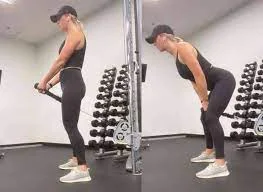
Example of a cable pull-through workout
How to apply
Attach the rope handles to a cable machine and set it to the lowest height possible. Bend down and grasp the ropes between your legs while turning your back on the machine. Grasping both ropes in a neutral grip, straighten your posture and advance a few paces until you sense strain on the rope. Take a straight, tall stance and place your feet shoulder-width apart. Slightly bend both of your knees. Hold your spine neutral and hinge at the hips. Allow the cable to go between your legs as you lower your chest towards the floor.
To get back to your starting position, clench your muscles when you feel a stretch in your glutes. Finish the specified number of repetitions. It’s time to go on to the gluteus medius-targeting abduction-based workouts.
15. Glute Hyperextension
The Glute Hyperextension is a fantastic exercise for your upper glutes. Take full advantage of the glute hyperextension bench in your gym if you’re good enough to have one. This exercise is an excellent way to work your hamstrings, lower back muscles, and upper and lower glutes.

Example of a glute hyperextension exercise
How to apply
Perform a hyperextension bench position where your hips line up with the bench’s edge. To find a comfortable position, some trial and error may be involved. Attach your feet under the footpads to create a push-off platform. Crossing your arms across your chest could be a good idea if you’re using your body weight as resistance.
When utilizing weights, you should reach down and seize the plate, barbell, or dumbbell. On the platform, turn your feet slightly outward.
This aids in attracting more upper gluteal fibers. Tucking your chin into your body will round out your upper back.
Once more, this is helpful.
16. Kickback of cable leg
Although you’re standing up, this activity does appear to be horizontally heavy. In contrast to an asquat, when the load is pressing down on you, the load is in front of you, requiring your glutes to work hard to push the weight backward.
The cable leg kickback is an excellent workout to help relieve stress on the hips and joints because it has a much lower impact due to its cable design.
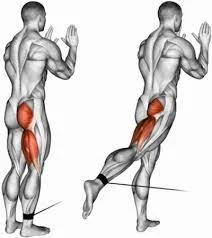
Example of a cable leg kickback workout
How to apply
Attach the ankle attachment after setting up a cable machine in the lowest position.
We’ll be exercising one leg at a time, so adjust the weight to something you can comfortably lift. Put a strap over one ankle and turn to face the device.
Step backward a few times until you feel the cable become tense. Take a forward bend and grasp the machine for stability. Put yourself in a position where your knees are slightly bent.
With the machine held in place for support, raise the leg with the ankle attachment off the ground.
As shown in the above image, pull the cable backward and behind your body.
As with the hip thrust examples, the pinnacle of the exercise is attained when your thigh lines up with your spine. To target the gluteus medius, return the weight slowly to the starting position and perform the required number of reps. Then, move on to the next leg number of sets, and rep-based exercises.
17. Thruster

How to Go About It:
- Place your feet shoulder-width apart and hold dumbbells in the front-rack position to get started.
- Lower into a squat, then explode to stand, activating glutes, pressing hips forward, and locking out knees; use momentum to help drive the weights overhead, palms facing each other. That is one repetition.
- Reverse the motion immediately, lowering the weights to the front-rack position and transitioning into a squat.
Expert advice:
This move relies heavily on foot placement. Your feet should be slightly wider than shoulder width, with toes slightly pointed outward.
Variation:
This move is a combination of a jump squat and a kettlebell press-out with a squat.
18. Alternating Lateral Lunges
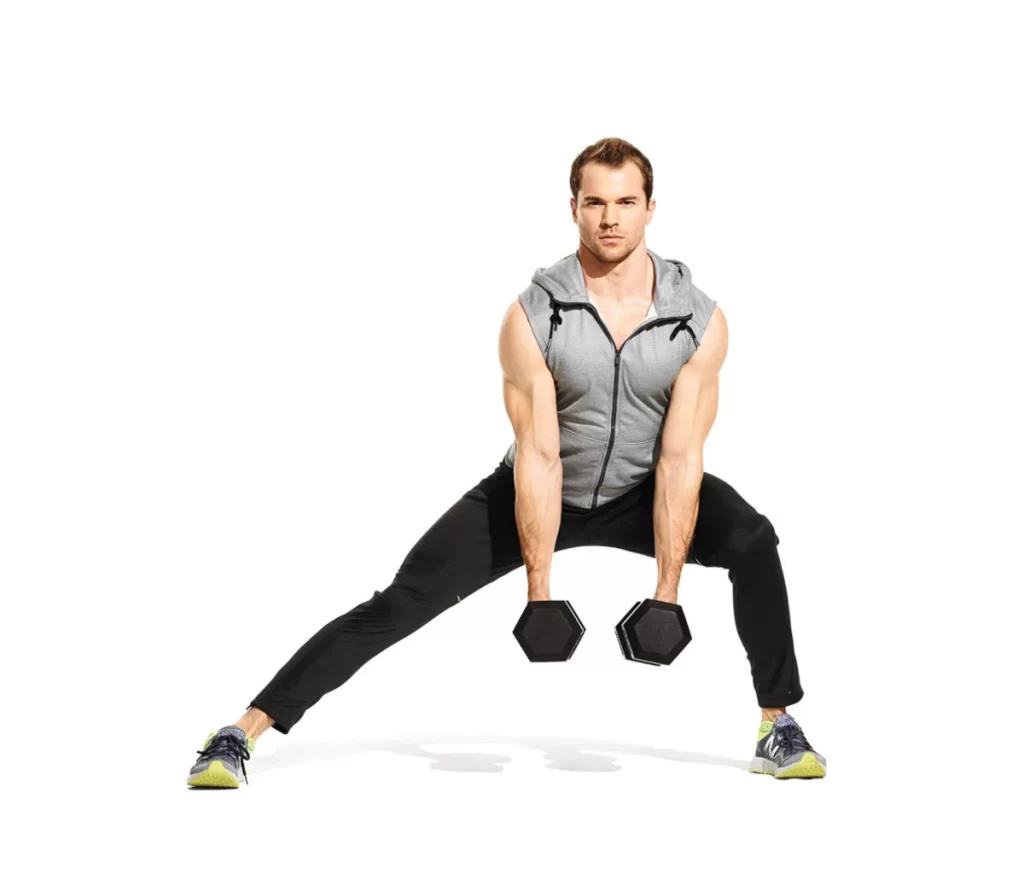
How to Go About It:
- Stand with dumbbells in each hand at your sides (you can also use your body weight).
- Step to one side and squat with the stepping leg while keeping the other leg straight to lower your hips to the ground.
- Keep your arms still, with one dumbbell on the outside of your squatting leg and the other between your legs—or put both arms between your legs.
- Return to the starting position by pushing up with your bent leg. Rep on the opposite side. That is one repetition.
Expert advice:
Throughout the movement, keep your shoulders square.
Variation:
This move can also be done without weights by bringing your left arm across your body to touch your right toes while keeping your back straight and shoulders square.
Upper Glute Workout Plans
Upper Glute Training Plan
- Exercise Sets Reps Rest Period
- Lateral Leg Raises 3 12-15 per side 1.5-2 minutes
- Banded Lateral Walks 3 10-15 per direction 1-5-2 minutes
- Clam Shells 2-3 12 to 20 per side 1-1.5 minutes
A Workout Program to Strengthen Your Entire Glute Region
- Exercise Sets Reps Rest Period
- Hip Thrust 3 5-8 2-3.5 minutes
- Bulgarian Split Squats 3 10-12 per leg 1.5-2 minutes
- Lateral Lunge 3 20-24 total 1.5-2 minutes
Upper Glute Workout in the GYM
- 4 sets of 8 repetitions of barbell hip thrust
- 3 sets of 10 repetitions on the gluteus maximus.
- 3 sets of 12 repetitions (each leg) of cable kickback
- Three sets of twelve reps on the hip abduction machine
- Banded Glute Bridge – 3 Sets of 15 reps
Glute Workout at home
- KAS Glute Bridge: Four Sets, Ten Repetitions
- Cable Pull-through – 2 to 3 Sets of 10- 12 repetitions
- Curtsy Lunge – 2 to 3 Sets of 10 -15 repetitions (each leg)
- 3 sets of 12 repetitions (each side) of side lying hip raise
- Clam Shells – 3 sets of 12 reps (each side
Exercises with Bands
Resistance bands are a great way to work the upper glutes at home, especially if you don’t have any other form of external resistance or weights.
1. Kickbacks with Quadrupled Bands
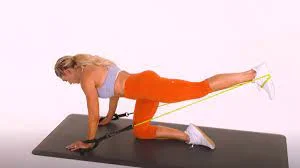
Here’s how to go about it:
- Position yourself quadrupedally, on your hands and knees, with your back as flat as possible.
- Wrap the closed-loop band around your right hand.
- Insert the sole of your left foot into the opposite loop.
- Kick your left leg back from the quadruped position, so it is straight behind you.
- You will need to experiment with band placement to ensure that it provides sufficient resistance.
- Return to the starting position slowly.
- Rep, making sure to train the opposite leg.
2. Banded Seated Hip Abduction
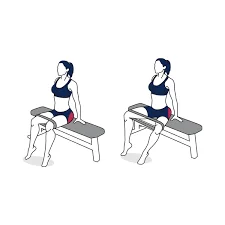
Here’s how you do it:
- Position yourself on your hands and knees, quadrupedally, with your back as flat as possible.
- Wrap your right hand in the closed-loop band.
- Insert your left foot’s sole into the opposite loop.
- From the quadruped position, kick your left leg back so it is straight behind you.
- Experiment with band placement to ensure that it provides adequate resistance.
- Slowly return to your starting position.
- Rep, ensuring that the opposite leg is trained.
3. Clam Shells

Here’s how to go about it:
Position yourself on your forearm, with both knees bent and a mini band wrapped around your knees. (I’m doing this exercise with a light band). Externally rotate your top leg as far as you can while keeping your feet in contact.
Return to the starting position slowly.
Repeat, making sure to train the opposite leg.
4. Glute Bridge With Banding
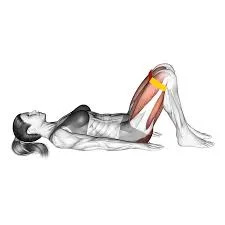
The glute bridge is a well-known exercise that focuses on the gluteus Maximus (the biggest glute muscle). Placing a band around the knees and pressing outwards during the exercise means that the glutes will be working hard not just to extend the hips, but also to maintain the knees pushed out. Benefits are multiplied by two! The example of a banded glute bridge exercise
A simplification of a banded glute bridge exercise
How to:
Place a resistance band around your knees while sitting on the floor in front of a bench/platform.
Bend your knees and lie on your back on the floor.
Place one foot at a time onto the platform in front of you (you may need to move towards/away from the bench to get your desired posture; the upper leg should be roughly perpendicular to the floor).
On the bench, keep your feet shoulder-width apart. Push your knees outwards once you’re comfortable.
Contract the glutes to bring your hips towards the ceiling (while preserving tension on the band) whenever you feel tension in the upper glutes.
The hamstrings and back will be aligned at the top of the exercise. Return to the starting position gently after you’ve reached this position. Anything over this may result in useless sets. As a result, we recommend two weekly glute training sessions for this lifter, with 8 sets completed in one session and 7 sets completed in the other.
5. Banded Lateral Walks
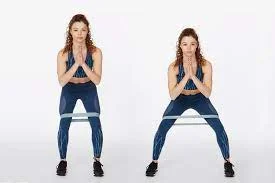
Here’s how to go about it:
- Wrap a medium-strength hip resistance band around your legs at the knees.
- After that, take a comfortable stance with your knees bent, your feet shoulder-width apart, and your toes pointing forward.
- Maintain a tight core and a raised chest.
- Step out to the right with your right foot from here.
- Then, with your left foot, take a step to the right.
- Continue lateral walking for the desired number of repetitions.
- To keep your glutes in constant tension, complete all of the reps on one side before moving on to the next!
6. Hip Abductions with Prone Bands
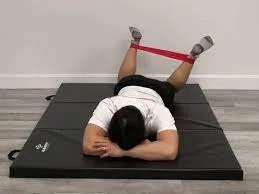
Here’s how to go about it:
- Wrap an elastic band around your ankles.
- Lie down on a bench, your legs dangling over the edge.
- Separate your heels and bring them back together quickly.
- With each repetition, squeeze your glutes.
- Upper Glute Banded Exercises
- 0 seconds out of 40 the 90th volume
Volume and Rep Range Procedures
Instead of delving into the exercises, let’s talk about muscular building.
The main process of muscle growth is called progressive overload, in which the muscle is subjected to gradually higher demands to force it to adapt and grow. However, we aren’t just going for pure strength here because the objective is hypertrophy or the expansion of the muscle size. We must use rep ranges and loads to develop our upper glutes to promote muscular size.
You can incorporate these exercises into your program as a “booty day” or spread them out for the week. The following exercises are given in the order that I would perform them at the gym.
Hip external rotation, or simply turning the feet outward, is the second function of the gluteus medius.
Yoga Poses for Upper Glutes:
Here’s a deeper dive into some of the poses mentioned earlier, with variations and additional tips for targeting your upper glutes:
Bridge Pose (Setu Bandhasana):
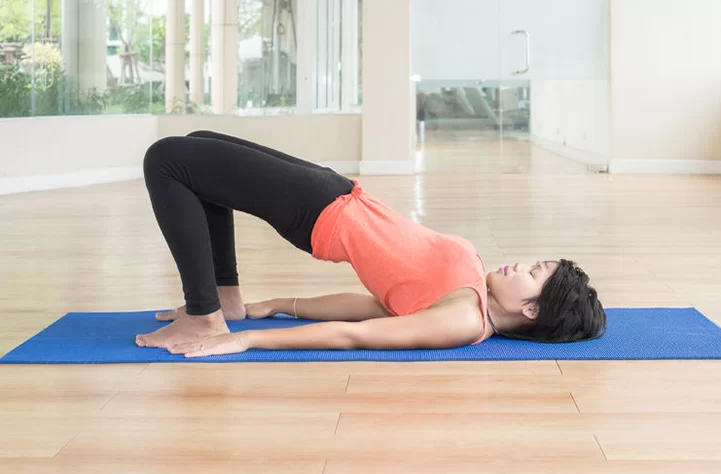
- Focus: Squeeze glutes at the top of the pose, feeling them lift your hips towards the ceiling.
- Variations:
- Elevated Bridge: Place blocks under your heels for a deeper glute engagement.
- Single-Leg Bridge: Extend one leg straight up, keeping your core engaged and hips level.
- Pulses: At the top of the pose, pulse your hips up and down for 5-10 repetitions.
Warrior II Pose (Virabhadrasana II):
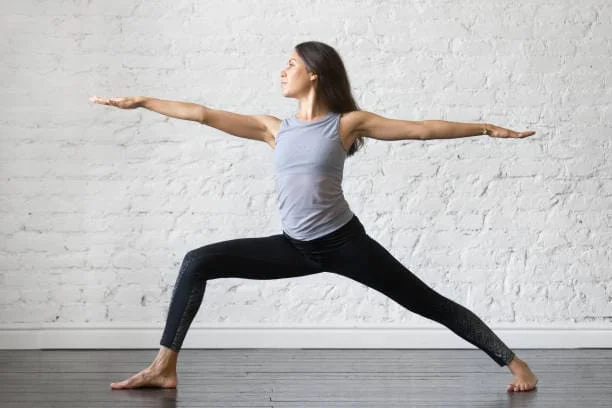
- Focus: Sink your hips and press your back heel firmly into the mat, engaging your gluteus maximus and medius.
- Variations:
- Wide Stance: Widen your stance for a deeper stretch in the inner thighs and greater glute activation.
- Arms Overhead: Raise your arms overhead with palms facing each other, opening your chest and engaging your shoulders.
- Warrior III: From Warrior II, step your front foot forward and extend your back leg straight back, balancing on one leg.
Quadruped Position Bird Dog Exercise (Gata Vyayamasana):
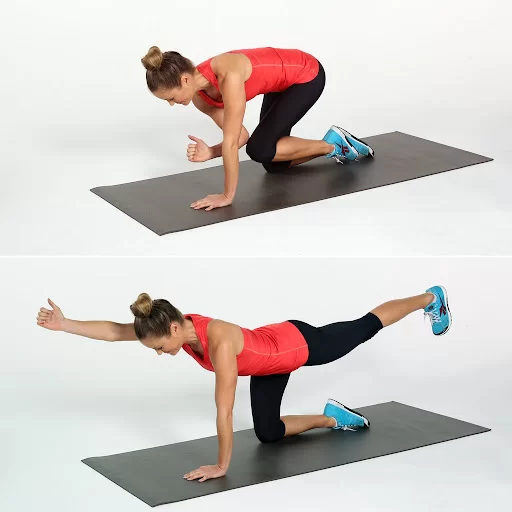
- Focus: Push your extended leg back and down, feeling your gluteus maximus engage and lift your hip. Keep your core engaged and spine neutral.
- Variations:
- Circles: With your extended arm and leg, draw small circles in the air, maintaining good form.
- Pulses: Pulse your extended leg up and down for 5-10 repetitions, keeping your core engaged.
- Plank with Bird-Dog: Start in a high plank position, then do the Bird-Dog movement with one arm and leg.
Firefly Pose (Makarasana Crocodile Pose):

- Focus: Squeeze your glutes and hamstrings to keep your body lifted and stable. Imagine your hips drawing towards your ribs.
- Variations:
- Dolphin Pose: Lower your forearms to the mat and keep your elbows shoulder-width apart.
- Low Plank: Lower your hips closer to the mat for a more challenging core and glute engagement.
- Leg Lifts: While in Firefly, lift one leg slightly off the mat and pulse it up and down for 5-10 repetitions.
Additional Tips:
- Visualization: Imagine a string pulling your upper glutes towards the ceiling in each pose.
- Mind-Muscle Connection: Focus on feeling the specific muscles working in each pose, rather than just going through the motions.
- Breath: Coordinate your breath with your movements, inhaling as you expand and exhaling as you contract.
- Hold Time and Repetitions: Start with shorter holds of 5-10 breaths and gradually increase as your strength improves. Aim for 3-5 sets of each pose.
- Warm-up and Cool-down: Don’t forget to warm up your muscles before practicing and cool down afterward with gentle stretches.
Remember, listen to your body and modify any poses as needed to avoid injury. Enjoy your yoga practice and feel the strength and definition building in your upper glutes.
What Equipment Works The Upper Glutes?
If you have access to a gym and prefer machines, try these exercises to help build upper gluteal muscles.
Gym Equipment:
- Hip Thrust Machine: This machine isolates the glutes perfectly, mimicking the hip extension movement of a glute bridge with added weight.
- Cable Machine: The versatility of cables allows you to perform various exercises like cable kickbacks, hip abductions, and side lunges, all focusing on the upper glutes.
- GHD Machine: This machine challenges your hamstrings and glutes with hip extension exercises like GHD raises and hamstring curls.
- Leg Press Machine: While primarily targeting quads, adjusting your foot placement higher on the platform can engage the glutes more.
- Smith Machine: Squats and lunges performed on the Smith machine allow controlled movements with added weight, targeting multiple lower body muscles, including the upper glutes.
Free Weights:
- Barbells: Barbell hip thrusts and Romanian deadlifts are excellent exercises for activating the upper glutes with progressive overload.
- Dumbbells: Dumbbell glute bridges, lunges, and step-ups offer flexibility and unilateral training, ensuring both glutes get equal attention.
- Kettlebells: Swings and cleans with kettlebells are dynamic exercises that hit multiple muscle groups, including the upper glutes, while improving core stability.
Why is it important to train your glutes?
The glutes, along with the hamstrings, calves, and back, are the most powerful muscles in the human body.
This muscle group—dubbed the “posterior chain”—generates more force than any other human movement, whether power cleans, deadlifts, box jumps, or simply lifting a heavy suitcase off the floor and into the overhead compartment.
Will glute exercises increase the size of your buttocks?
That’s correct, and it’s a good thing. You want your glutes to be firmer and more muscular, but as with any transition from flab to muscle, the result will be an optical illusion because you will be leaner and possibly lighter.
More Upper Glute Exercises
Ali adds that if you have access to a gym or gym equipment, several machines target your glutes in addition to the exercises listed above.
“The gym allows you to lift heavier,” she says, recommending glute-targeting exercises like barbell deadlifts, barbell squats, and cable kickbacks.
Heavy hip bridges (with a weighted barbell) and kettlebell swings are also effective at targeting and strengthening glute muscles.
Don’t forget about cardio, either. Cardio is also beneficial when targeting your glutes, and sprints and plyometric moves like jump squats and jump lunges can’t go wrong.
The Advantages of Strong Glute Muscles
Your glutes are made up of three muscles: the gluteus maximus, the gluteus minimus, and the gluteus medius. The gluteus maximus and gluteus medius comprise the upper- glute shelf.
The large gluteus maximus occupies the majority of your backside. This muscle allows you to extend your leg back and turn your leg outward. The gluteus medius is a smaller muscle that works with the gluteus minimus to help you move your leg out to the side and inward.
When you walk, run, stand, bend over, and stand up, your glutes help stabilize and support your pelvis and back. They also aid in balance and provide force when sprinting or jumping. Your glutes are what allow you to perform most lower-body movements.
So, strengthening your glutes not only gives you a sculpted backside but also has real-world applications.
Upper glute strength is important for your health, functionality, and performance in the gym. The muscle helps to stabilize the pelvis and supports your body during most activities such as squatting, pull-ups, and overhead presses.
Developing your glutes is also important for your daily life. Poor hip alignment makes it difficult to perform simple tasks, and excessive pelvic movement increases the risk of spinal injury
Did you know that?
During activities where one foot lifts off the ground (walking, running, single-leg activities, etc.), your glute medius keeps your pelvis level.
Regardless of hip position or body alignment, the glutes cause hip abduction (bringing one leg to the side).
Due to a lack of hip stability or alignment, you could not stand or walk without the glutes. Bringing one leg forward causes the opposite side of your pelvis to drop.
Weighted compound exercises that target your glutes include dumbbell front squats, Bulgarian split squats, sumo deadlifts, and back hyperextensions.
Alternatively, try bodyweight or resistance band moves such as banded wall clamshells, hip bridges, and Superman holds at home.
Train your glutes and lower body two to three times per week. Choose at least one glute exercise and do 2-3 sets of 12-15 reps per exercise
Butt Workouts: How to Program Them
Don’t expect to go to the gym and do every single glute exercise listed below in a single glute workout. The glutes are powerful, but they are not invincible.
Instead, divide this list of exercises into four or five groups to target your gluteus minimus, gluteus medius, and gluteus maximus (the largest muscle in the body). Combine a few moves that all require the same piece of equipment, such as a suspension trainer, Swiss ball, or barbell. Glute workout equipment can range from machines to free weights to no equipment at all (think sprints, bodyweight squats, and lunges).
You can combine them as a circuit by performing as many reps of each exercise as possible in 45 seconds, resting for 15 seconds before moving on to the next After each round of exercise, take a 2-minute break.
Alternately, perform these glute exercises in traditional straight sets—for example, 2 to 5 sets of 8-15 reps with 60 seconds of rest in between. To get the most out of these glute exercises, vary your rest, sets, reps, and exercise selection.
How Can You Maximize the Benefits of Glute Workouts?
Bodyweight training benefits the glutes more than any other body part, though dumbbells, barbells, and cables can also be used. Because most of us don’t think about glute activation, be mindful of firing (squeezing) those glutes during butt workouts. Slow down, maximizing time under tension during the eccentric portion of the lift, then hold before finishing with a fast concentric movement.
You can strengthen your glutes (and sculpt your butt) by varying your workload, training your muscles from different angles, and incorporating instability into your workout routines.
Consider life to be one daily glute workout in addition to your efforts in the gym. Simply squeeze each cheek one at a time, for example. This can be accomplished while in a meeting, on a conference call, or stuck in traffic. Look for opportunities to train your glutes throughout the day, such as taking the stairs instead of the elevator or squatting to pick something up instead of bending over at the waist.
Risk factors
here are some risk factors to consider when performing upper glute exercises:
Pre-existing conditions:
- Lower back pain: If you have a history of lower back pain, certain upper glute exercises like weighted hip thrusts or glute-ham raises can put additional strain on your spine. Opt for bodyweight exercises or lighter weights with proper form to minimize the risk of aggravating your pain.
- Hip pain: Similar to lower back pain, pre-existing hip pain can be exacerbated by exercises that involve excessive hip flexion or rotation. Choose exercises that are gentle on your hips, such as side-lying hip raises or clamshells
- Knee pain: If you have knee pain, lunges or exercises that require deep knee flexion might be uncomfortable or risky. Consider alternatives like step-ups or hip abductions with a resistance band.
Improper form:
- Arching your back: Excessively arching your back during exercises like hip thrusts can put a strain on your lower back and hamstrings. Focus on maintaining a neutral spine throughout the movement and engage your core for stability.
- Overextending your knees: In lunges or squats, avoid letting your front knee track beyond your toes. This can put undue stress on your knee joint and increase the risk of injury
- Not engaging your glutes: If you’re not feeling your glutes working during an exercise, you’re likely not using the proper form. Focus on the mind-muscle connection and ensure you’re initiating the movement from your glutes, not your lower back or hamstrings.
Overtraining:
- Doing too much glute work without adequate rest can lead to muscle fatigue, soreness, and even injury. Make sure to schedule rest days between workouts and allow your muscles time to recover.
Individual factors:
- Muscle imbalances: If you have imbalances between your glute muscles (e.g., one side is weaker than the other), certain exercises might exacerbate the imbalance. Choose exercises that target both sides equally and consider seeking help from a personal trainer to address any imbalances.
- Limited flexibility: If you have tight hamstrings or hips, it might be difficult to perform certain upper glute exercises with proper form. Focus on improving your flexibility before attempting complex exercises.
Remember, it’s always best to listen to your body and stop any exercise that causes pain or discomfort. Consulting a healthcare professional or certified personal trainer before starting a new exercise program is also advisable, especially if you have any pre-existing conditions or concerns
Complication
Complications can vary depending on the specific exercise, your fitness level, and any pre-existing conditions you might have.
To provide you with the most helpful information, I’d need some more details. Could you tell me:
- What specific upper glute exercise are you concerned about? Knowing the exercise name or a description of the movement would help narrow down potential complications.
- What kind of complications are you worried about? Are you concerned about pain, injury, muscle imbalances, or something else?
- Do you have any pre-existing injuries or conditions that might be relevant? This information would help me assess your risk factors and provide targeted advice.
Once I have a better understanding of your specific concerns, I can provide you with more accurate and relevant information about potential complications from upper glute exercises. Additionally, I can offer alternative exercises or modifications that might be safer and more effective for you.
Remember, it’s always best to consult a healthcare professional or certified personal trainer before starting any new exercise program, especially if you have any concerns about potential complications
Precaution
It’s great that you’re interested in building your upper glutes! While these exercises are fantastic for creating a sculpted and strong backside, it’s always important to be aware of potential precautions to avoid injury and maximize your training efficiency.
General precautions:
- Overtraining: Don’t overtrain your glutes! Too much exercise can lead to muscle fatigue, soreness, and even injury. Stick to a routine that allows for sufficient rest and recovery between workouts.
- Improper form: Prioritize proper form over heavy weights. Using incorrect forms can put unnecessary strain on your lower back and hips, increasing the risk of injury. Focus on mind-muscle connection and controlled movements during each exercise.
- Existing injuries: If you have any pre-existing injuries in your lower back, hips, or knees, consult a doctor or physical therapist before starting a new glute-focused exercise routine. They can help you choose exercises that are safe and effective for your specific needs.
- Listening to your body: Pay attention to your body’s signals. Stop any exercise that causes pain or discomfort. Pain isn’t a normal part of training, and pushing through it can lead to serious injury.
Exercise-specific precautions:
- Hip thrust: Avoid arching your back excessively to compensate for heavy weights. Keep your core engaged and maintain a neutral spine throughout the movement.
- Lunges: Don’t overstride or allow your front knee to track beyond your toes. Keep your hips square and knees aligned to avoid knee pain.
- Cable pull-through: Choose a weight that allows you to maintain proper form. Don’t hunch your shoulders or round your back during the pull.
- Glute-ham raises: This is an advanced exercise. Start with lighter weights and focus on controlled movements to avoid hyperextending your lower back.
Additional tips:
- Warm up before your workout with some light cardio and dynamic stretches to prepare your muscles and joints.
- Cool down with static stretches after your workout to improve flexibility and minimize muscular pain.
- Consider using a foam roller or massage ball to release tension in your glutes and surrounding muscles.
By following these precautions and listening to your body, you can safely and effectively build your upper glutes and achieve your fitness goals. Remember, it’s always better to err on the side of caution and prioritize proper form over heavy weights.
Conclusion
In conclusion, incorporating upper glute exercises into your routine is highly beneficial for:
Aesthetics:
- Sculpting and lifting the upper glutes: By targeting the upper fibers of the gluteus maximus, along with the gluteus medius and minimus, you can achieve a perkier, rounder, and more lifted backside.
Performance:
- Improving athletic performance: Strong glutes enhance power, stability, and propulsion in various exercises and sports.
Overall health:
- Enhancing posture and balance: Strong glutes support proper spinal alignment and prevent imbalances that lead to pain and injury.
- Preventing injuries: Well-developed glutes stabilize the pelvis and hips, reducing the risk of injuries like lower back pain and knee problems.
- Boosting confidence: Feeling strong and confident in your physique can have a positive impact on your overall well-being.
Here are some key takeaways for effective upper glute training:
- Focus on mind-muscle connection: Engage your glutes throughout each exercise and avoid relying on momentum.
- Vary your feet placement: Different stances activate different glute fibers, ensuring well-rounded development.
- Incorporate plyometric exercises: Jumping exercises like box jumps and squat jumps effectively target the glutes.
- Maintain proper form: Prioritize correct form over using heavy weights to prevent injury and maximize results.
- Be patient and consistent: Building muscle takes time and dedication. Stick to your routine and gradually increase the difficulty as you get stronger.
Remember, consistency and proper form are crucial for reaping the sculpting and functional benefits of upper glute exercises. Consult a certified personal trainer for personalized guidance and exercise variations tailored to your fitness level and goals.
FAQs
How long does it take for these muscles to grow?
You can expect to see glute growth in 8-12 weeks if you stick to a good training and nutrition plan.
However, it is difficult to predict how long it will take you to grow your glutes because it is dependent on several factors, including your:
Genetics
Body mass index
Lean muscle mass
and consistency
Diet
If you have exceptional genetics or are already lean, you may see results sooner
Why is the top of my bum flat?
Your bum could be flat at the top for one of the following reasons:
A sedentary way of life
Muscle mass has shrunk.
Genetics
Hormones
Consuming insufficient calories or the appropriate foods
Stress
Age
Pregnancy or postpartum period
gluteal weakness
Is it possible that my glutes are weak?
Your glutes are weak if you can:
you extend your hips and your lower back arches. When lifting heavy weights, you experience low back pain as well as hip or knee pain.
If you can’t get a full range of motion bridge position, you probably have weak glutes.
Why is it important to train your glutes?
The glutes, along with the hamstrings, calves, and back, are the most powerful muscles in the human body.
This muscle group—dubbed the “posterior chain”—generates more force than any other human movement, whether it’s power cleans, deadlifts, box jumps, or simply lifting a heavy suitcase off the floor and into the overhead compartment.
Will glute exercises increase the size of your buttocks?
That’s correct, and it’s a good thing. You want your glutes to be firmer and more muscular, but as with any transition from flab to muscle, the result will be an optical illusion because you will be leaner and possibly lighter.
Do I need equipment to work my upper glutes?
Not! Plenty of effective bodyweight exercises like clamshells, donkey kicks, and glute bridges can torch your upper glutes. However, if you want to add more challenge, equipment like dumbbells, resistance bands, or a barbell can take your workouts to the next level
What are some common mistakes to avoid when doing upper glute exercises?
Arching your back: Keep your core engaged and spine neutral during exercises like hip thrusts to prevent lower back strain.
Overextending your knees: In lunges, avoid letting your front knee track beyond your toes to protect your knee joint.
Not engaging your glutes: Focus on feeling your glutes working, not just moving the weight. Mind-muscle connection is key!
Overtraining: Don’t overdo it! Listen to your body and take rest days to avoid fatigue and injury.
Few signs which indicate the right track:
Increased strength and definition in your upper glutes
Improved athletic performance, especially in activities like jumping and sprinting
Reduced lower back pain (if previously present)
Feeling stronger and more confident in your body
How can I naturally increase the size of my glutes?
The key to getting a bigger butt is to exercise. To achieve the best results, concentrate on glute-targeting exercises such as squats and hip extensions. These exercises will help you build muscle in your glutes while also burning fat in other areas of your body.
What sports help you bulk up your buttocks?
The ideal sports for the buttocks you’ve always desired
Walking in the Nordic style. It entails actively walking while leaning on ski poles.
With short fins, perform a backstroke. As long as the strokes are wide and begin at the hips, this exercise interacts with all buttocks muscles.
Afro dance…. Rollerblading.
Aerobics in the water…
Volleyball on the beach
How much time does it take to develop upper glutes?
If you improve the elements we discussed today, you can see minor results as soon as 4-6 weeks. However, more noticeable changes will take place in 3-6 months. And you’re looking at 1-2 years to completely transform your buttocks.
How many glute exercises should you perform each week?
This, again, is dependent on a variety of parameters, including training age, training intensity, and training volume. A better approach to look at it is to think about how many weekly sets you should accomplish. According to current recommendations, 10-20 weekly sets are sufficient to gain muscle, with the lower end of the limit targeted toward inexperienced lifters and the upper end of the limit geared toward experienced lifters.
As an example, an intermediate lifter may require 15 weekly sessions per muscle group to gain muscle. Every workout is the recommended quantity of 10 sets per muscle group; anything more may result in wasted sets. As a result, we recommend two weekly glute training sessions for this lifter, with 8 sets completed in one session and 7 sets completed in the other.
References
- Stefanov, P. (2023, March 15). Develop a Shelf Butt: 2 Upper Glute Workouts and 10 Upper Glute Exercises. Hevy – #1 Workout Tracker & Planner Gym Log App. https://www.hevyapp.com/upper-glute-workout/
- Firman, T., Firman, T., & W. (2023, October 6). Upper Glute Workout: the 9 Best Exercises to Target Those Butt Muscles. Well+Good. https://www.wellandgood.com/upper-glutes-exercises/
- Hinchman, W., & Hinchman, W. (2023, March 14). Upper Glute Workout: 6 Upper Glute Exercises For Building Your Glute Shelf. Swolverine. https://swolverine.com/en-in/blogs/blog/upper-glute-workout-exercises
- Pt, K. G. (2023, November 10). The 6 Best Upper-Glute Exercises for a Sculpted Backside. LIVESTRONG.COM. https://www.livestrong.com/article/13776411-upper-glute-exercises/
- Cpt, B. R. M. M. (2023, March 9). 15 Best Upper Glute Exercises (2 Free Workouts Included). Postpartum Trainer, MD. https://postpartumtrainer.com/upper-glute-workout/
- Gharib, S. (2023, August 8). How to Get a Shelf on the Upper Glutes: 20+ Exercises. wikiHow. https://www.wikihow.com/Get-a-Shelf-on-the-Upper-Glutes
- Nunez, K. (2023, February 10). 7 Easy Ways to Stretch Tight Glutes. Healthline. https://www.healthline.com/health/exercise-fitness/how-to-stretch-glutes

